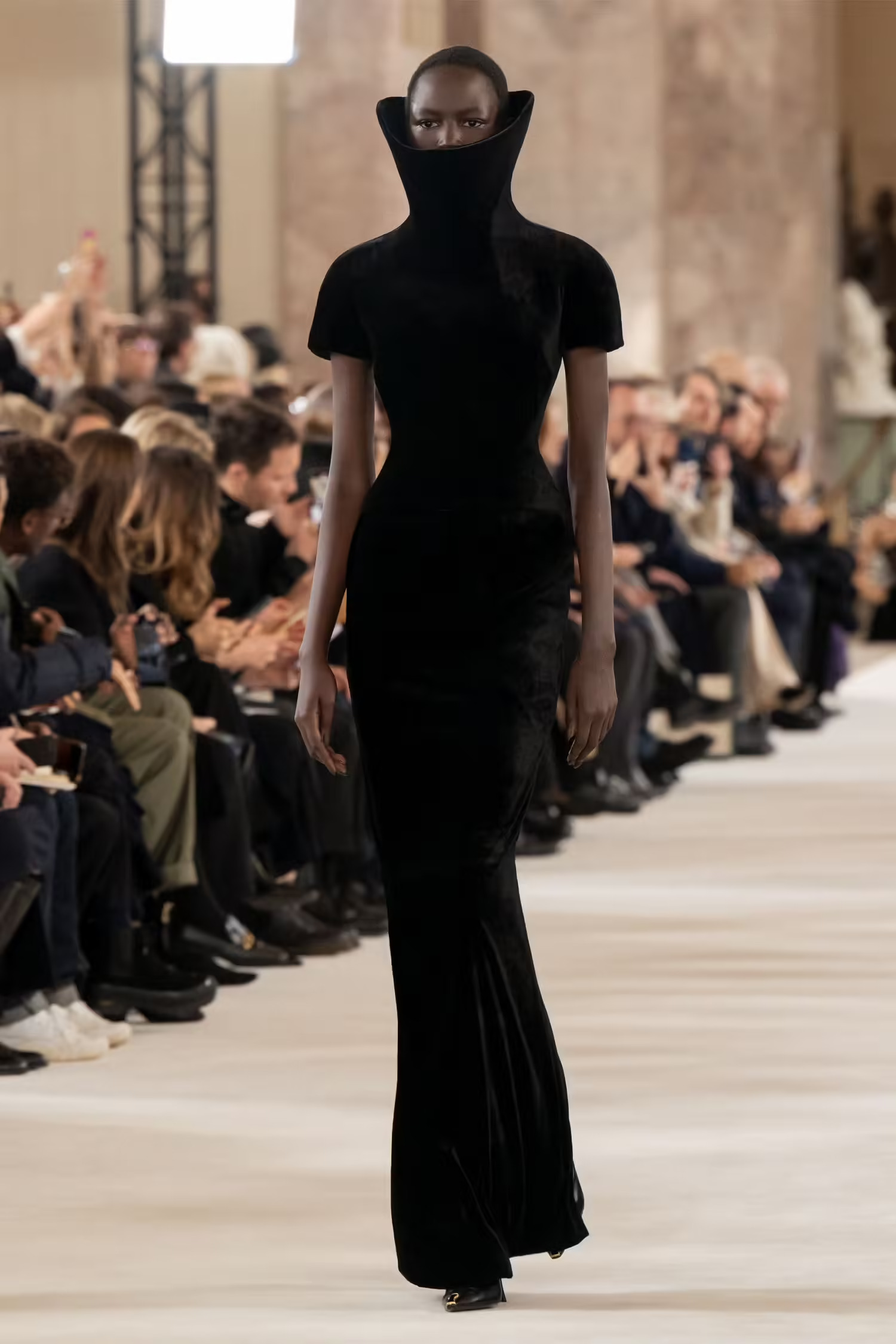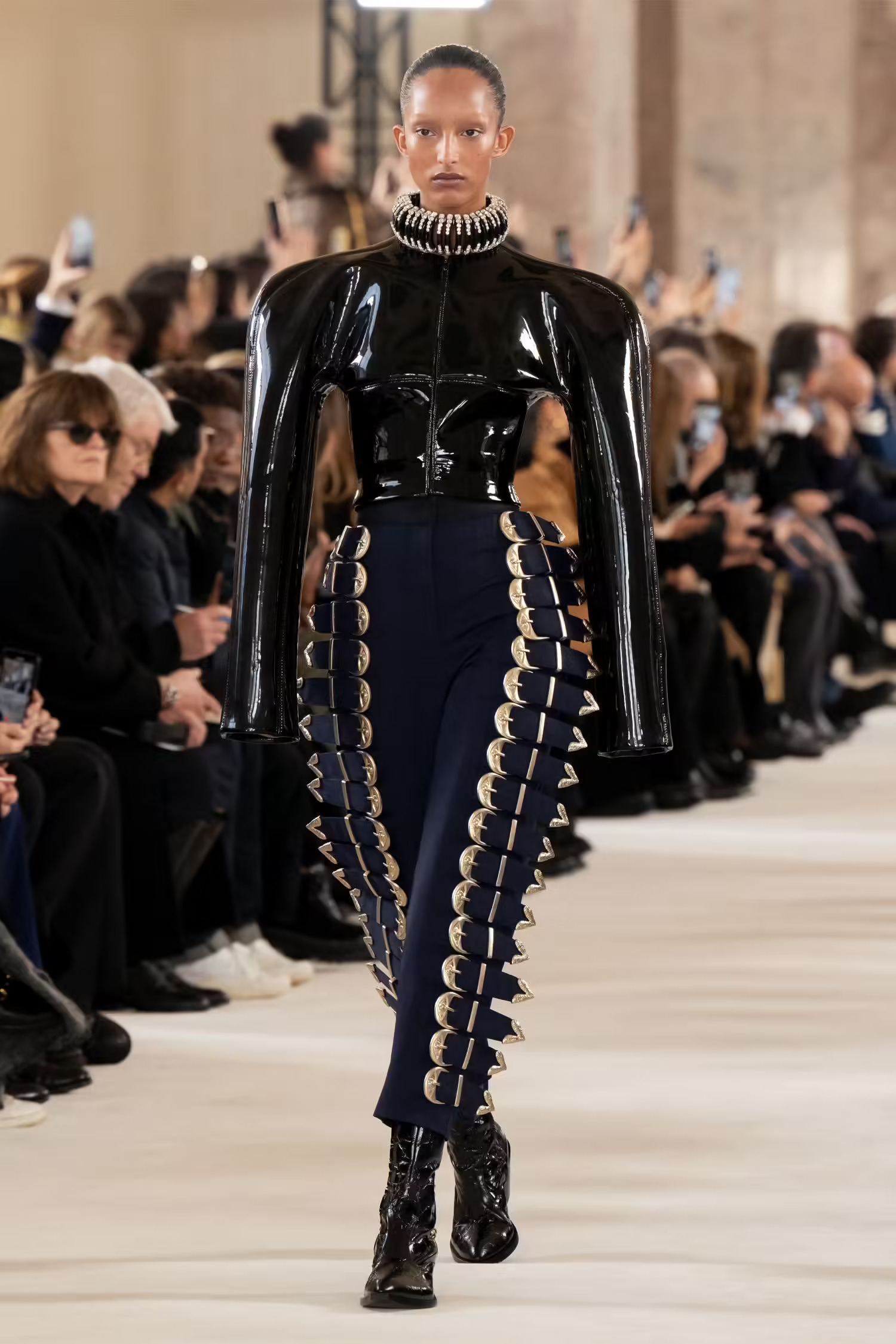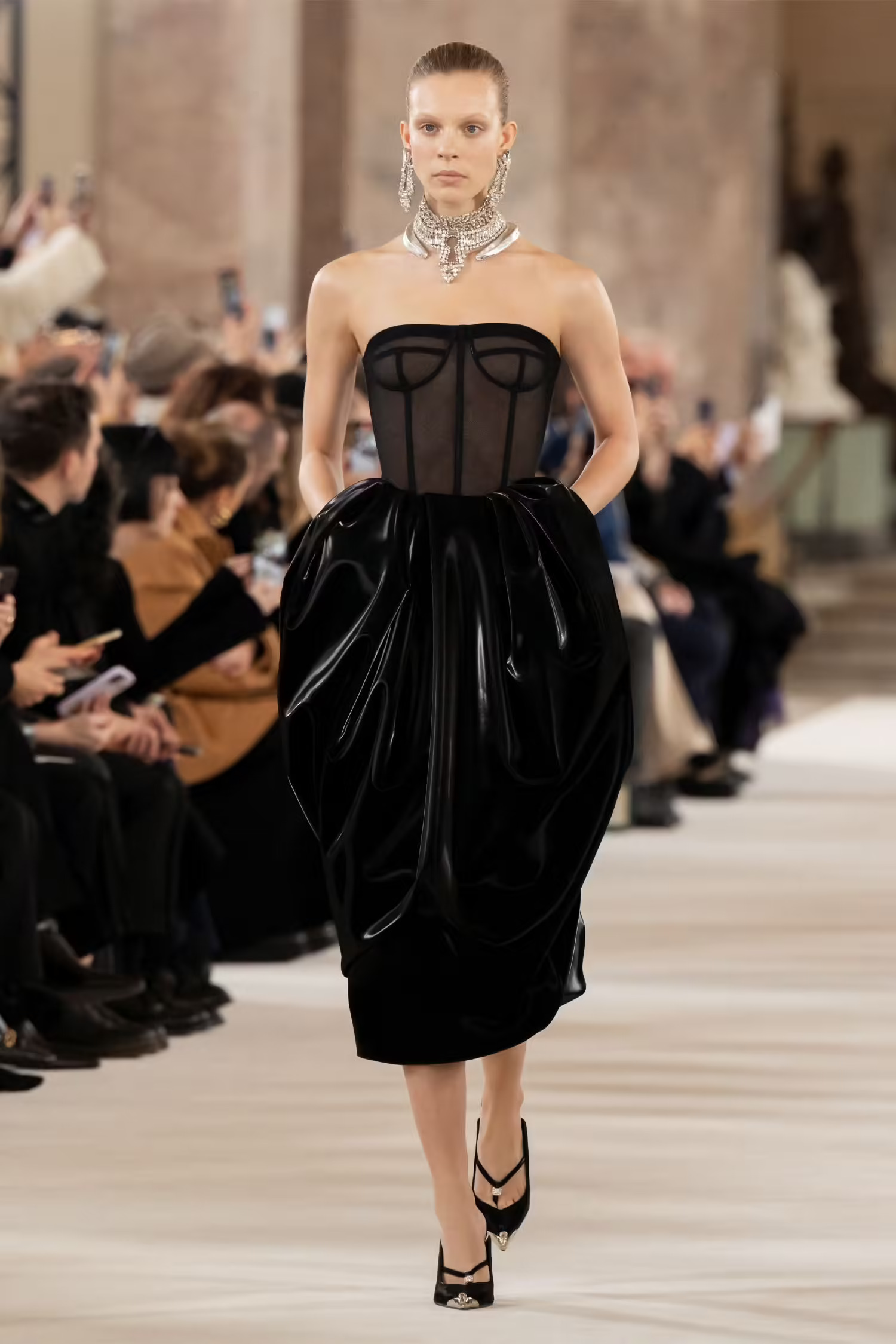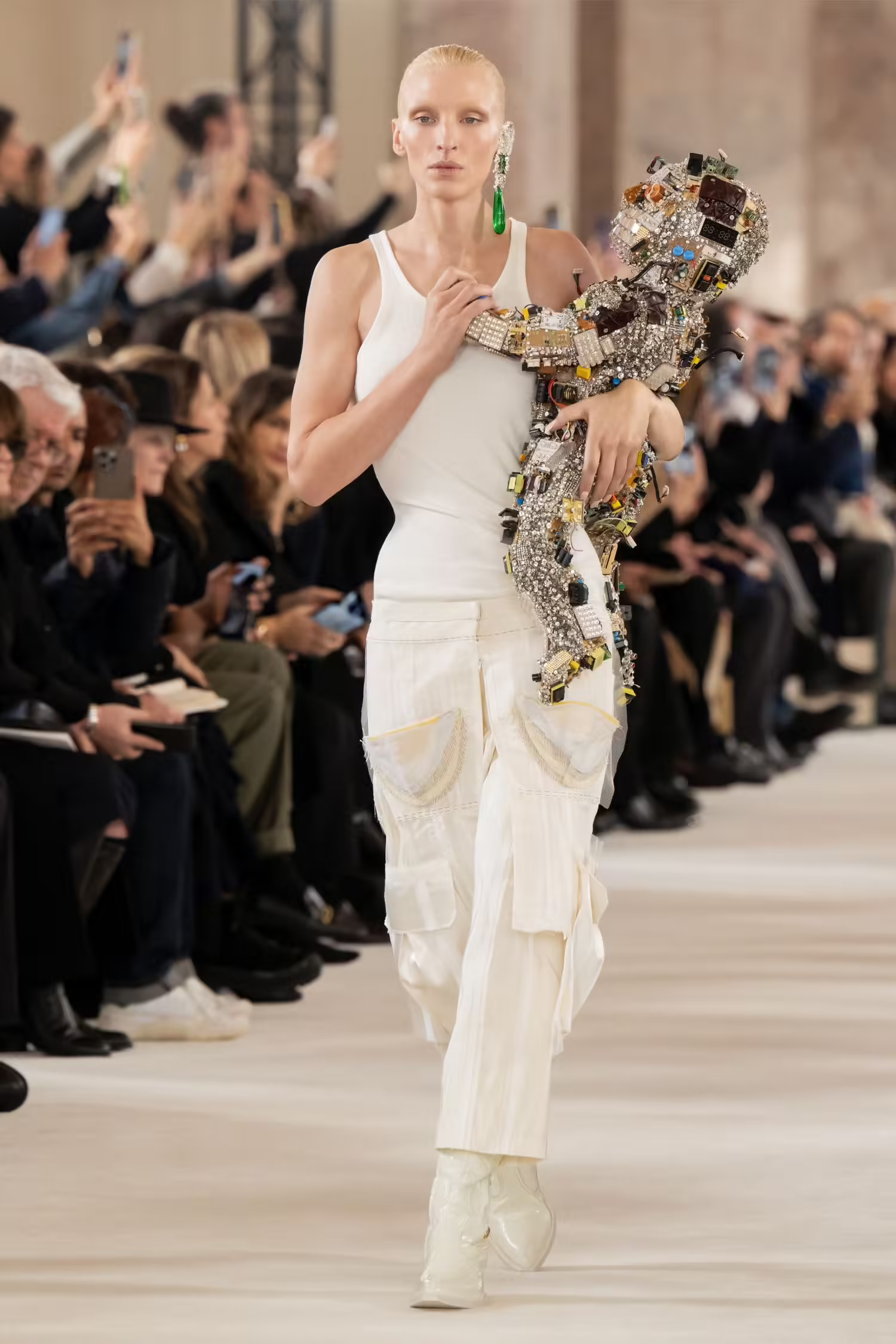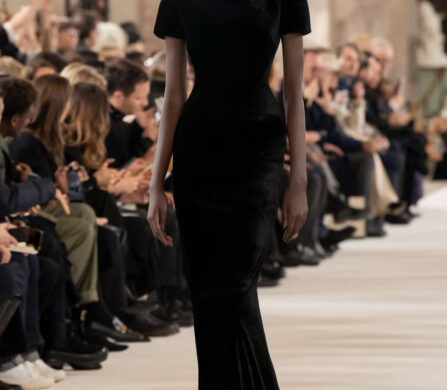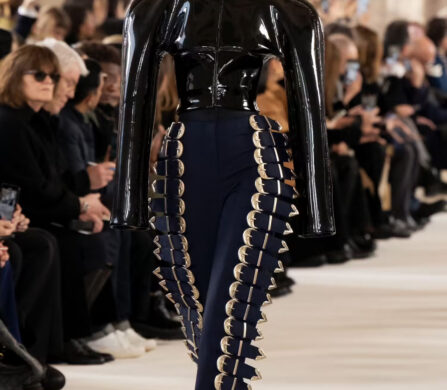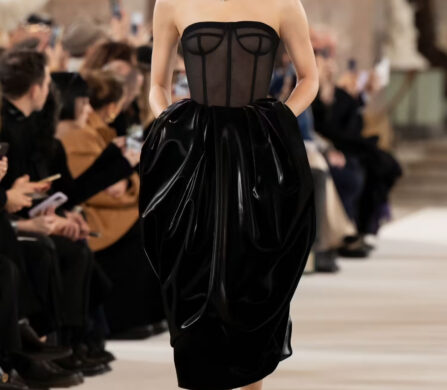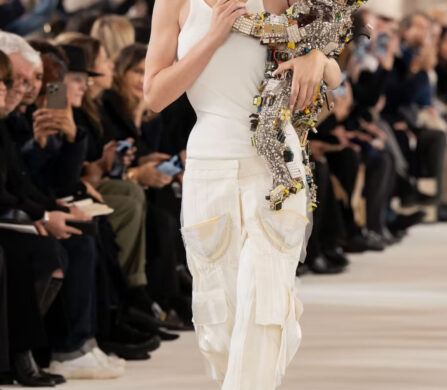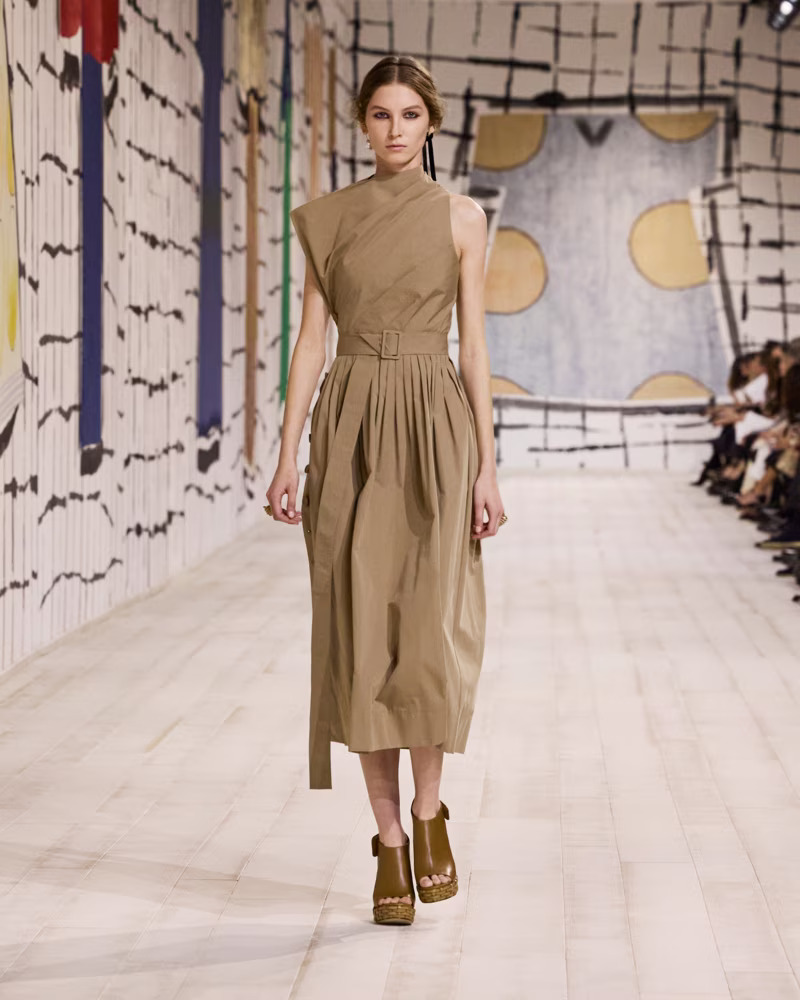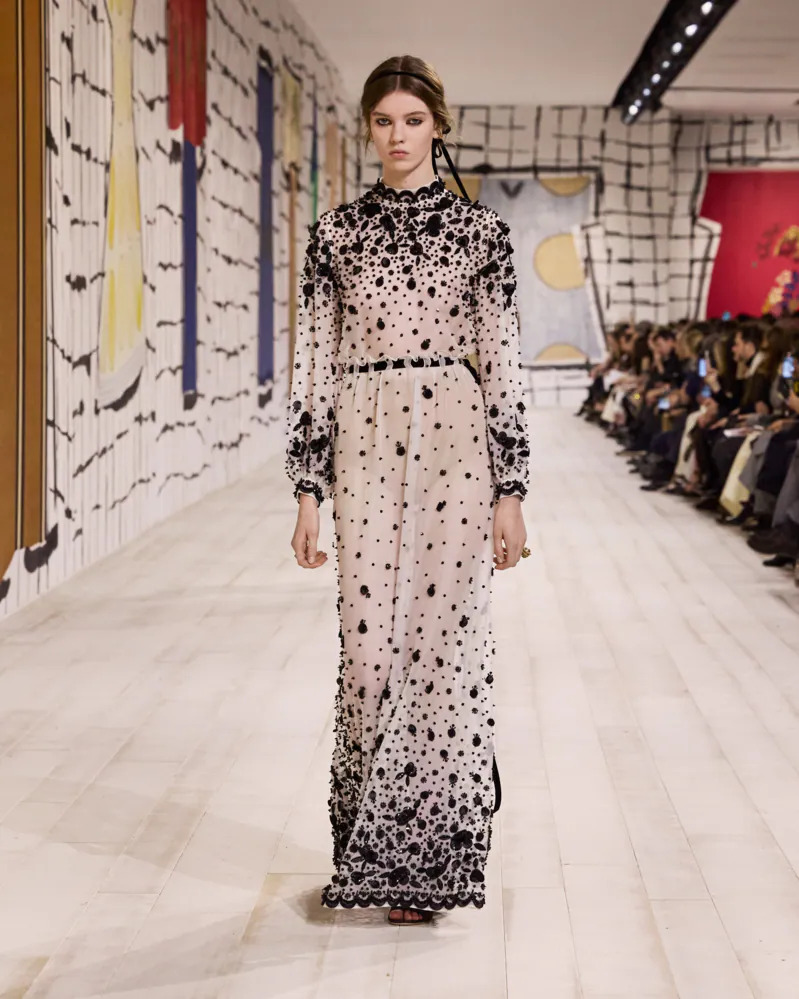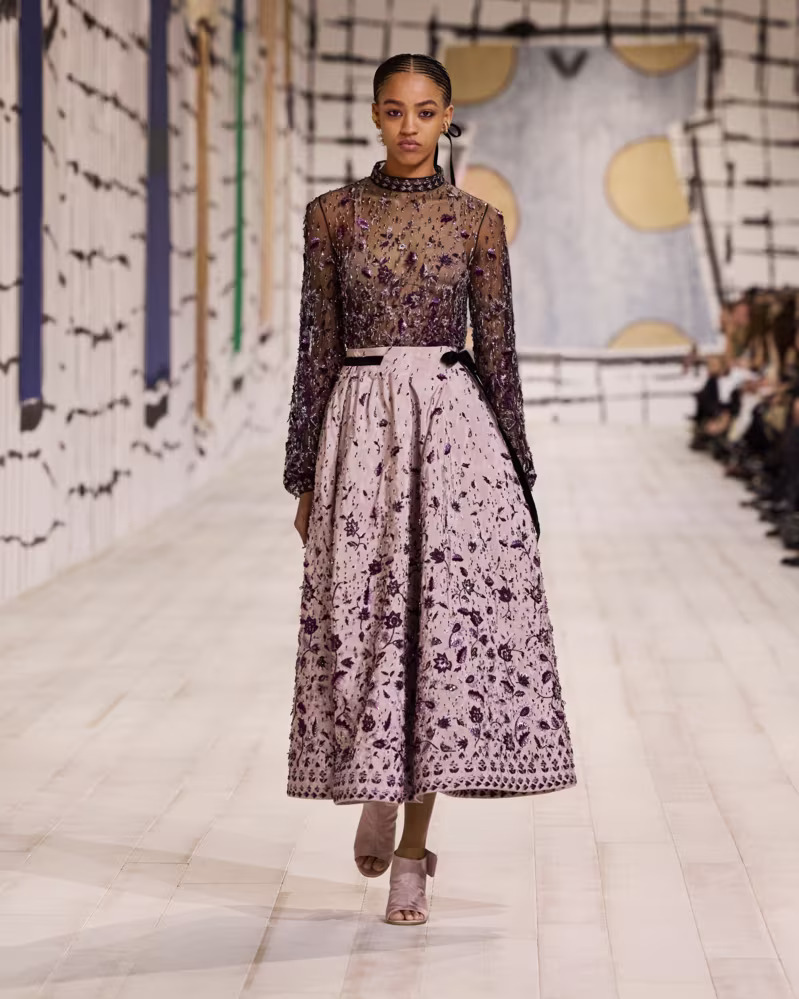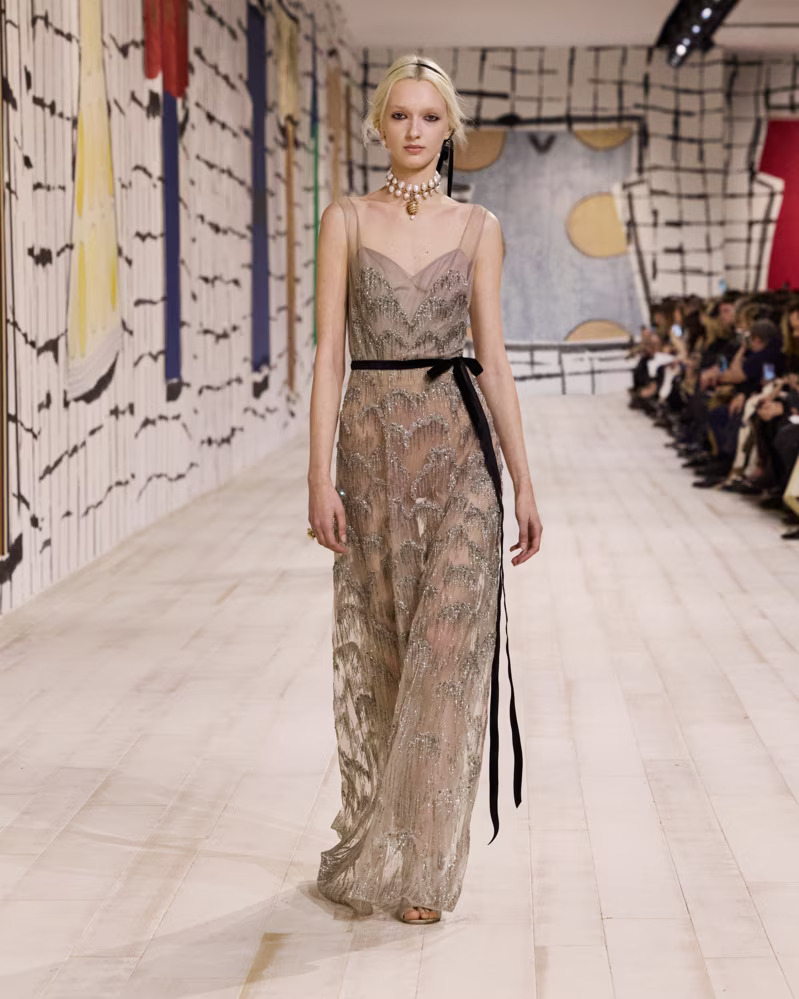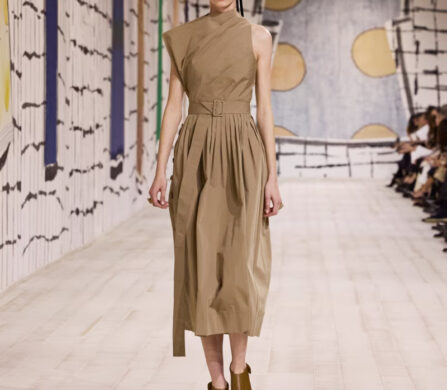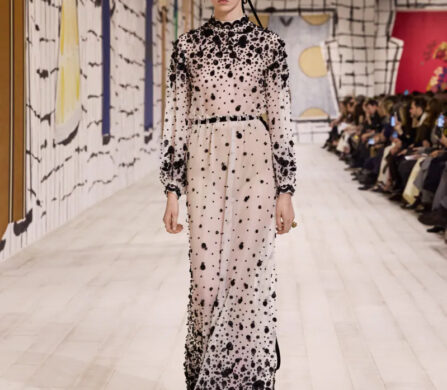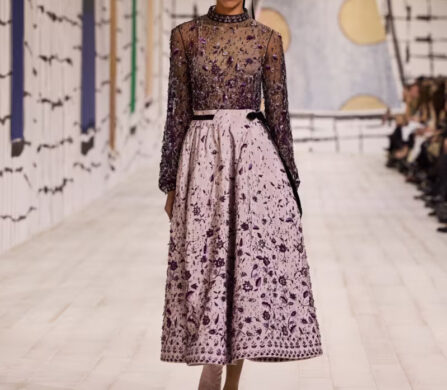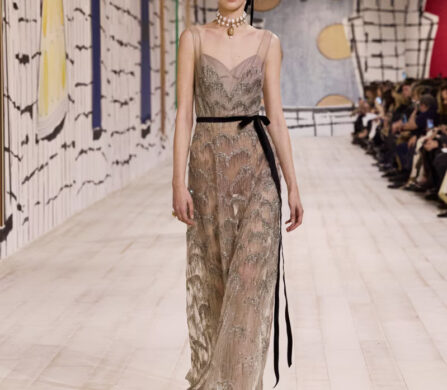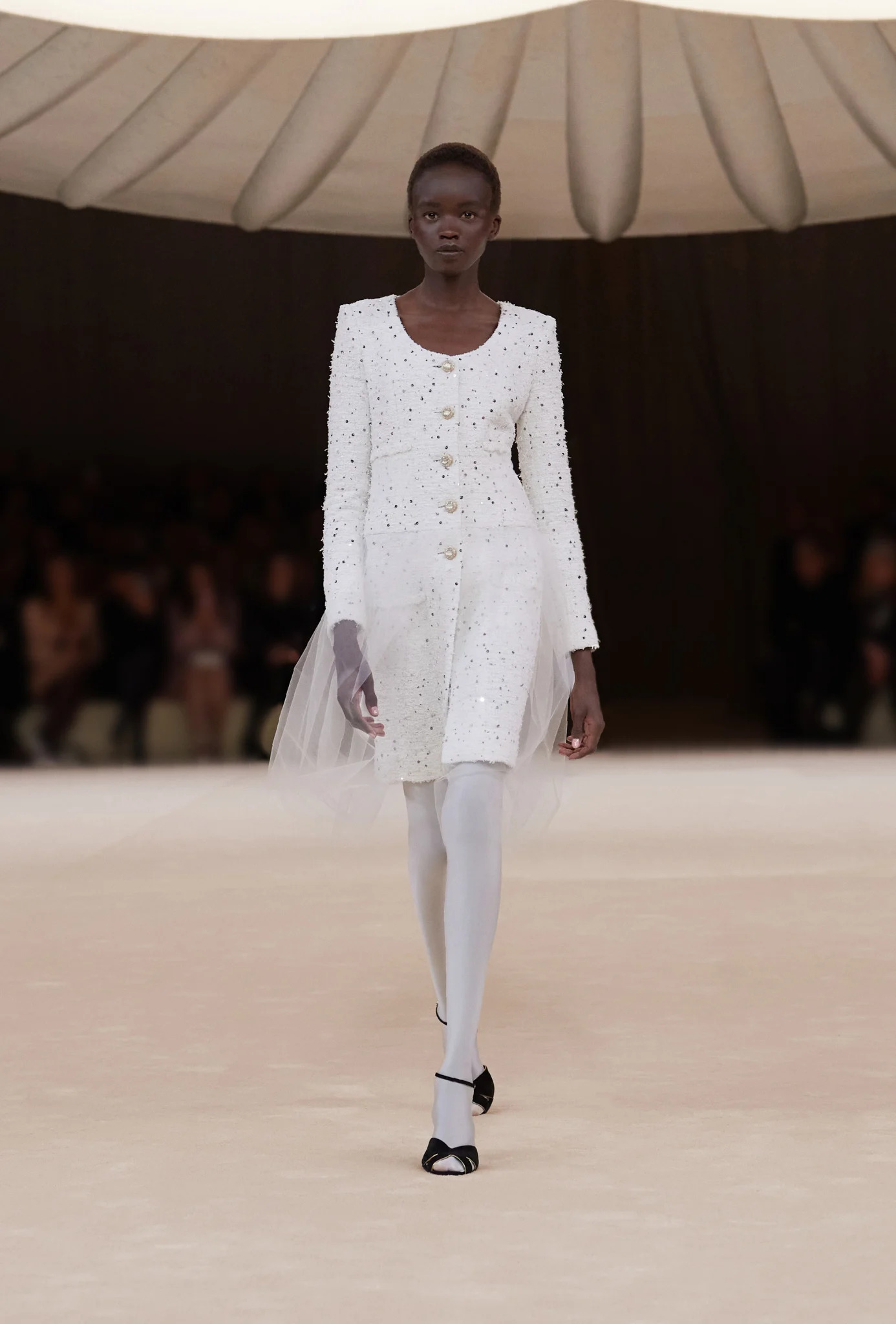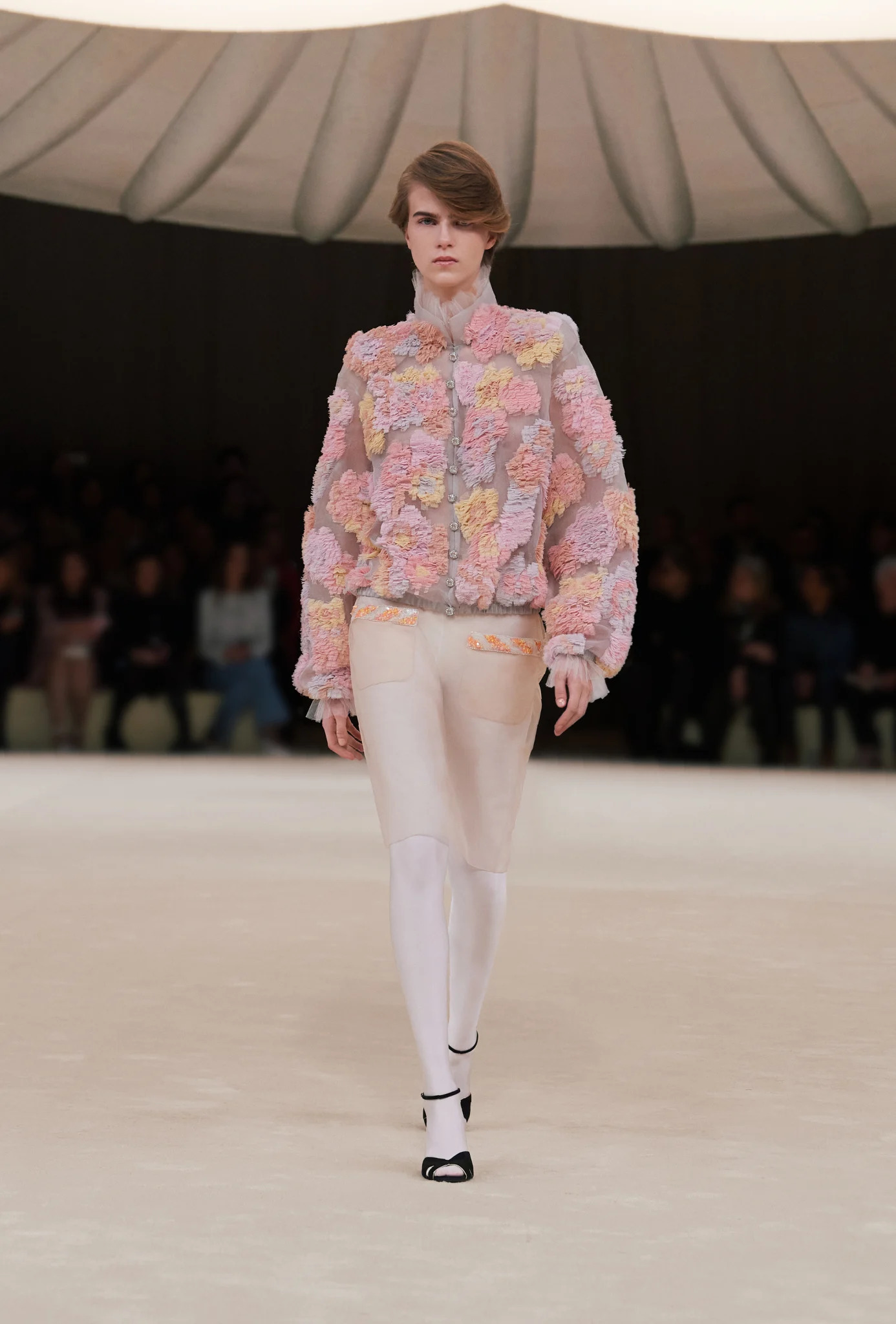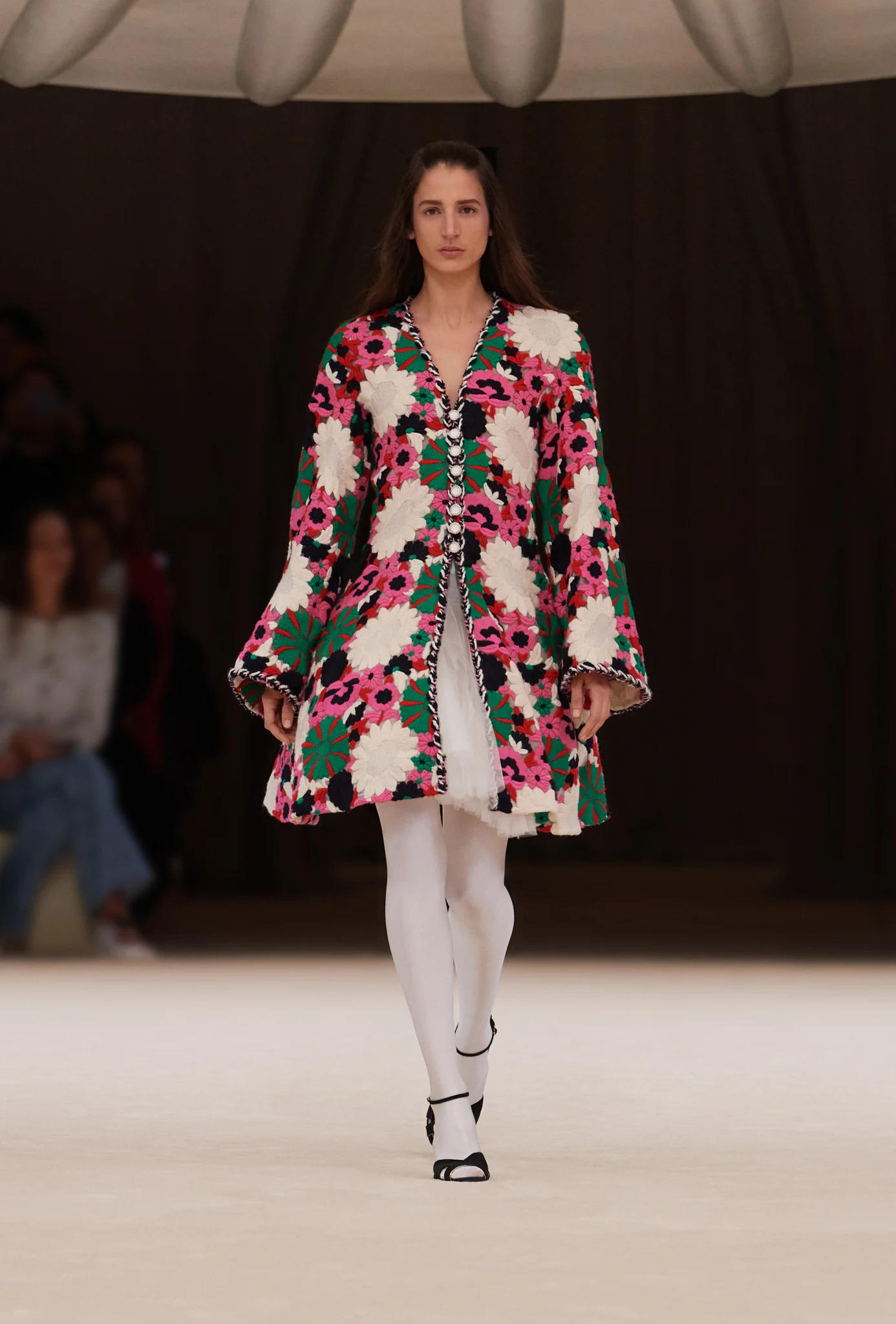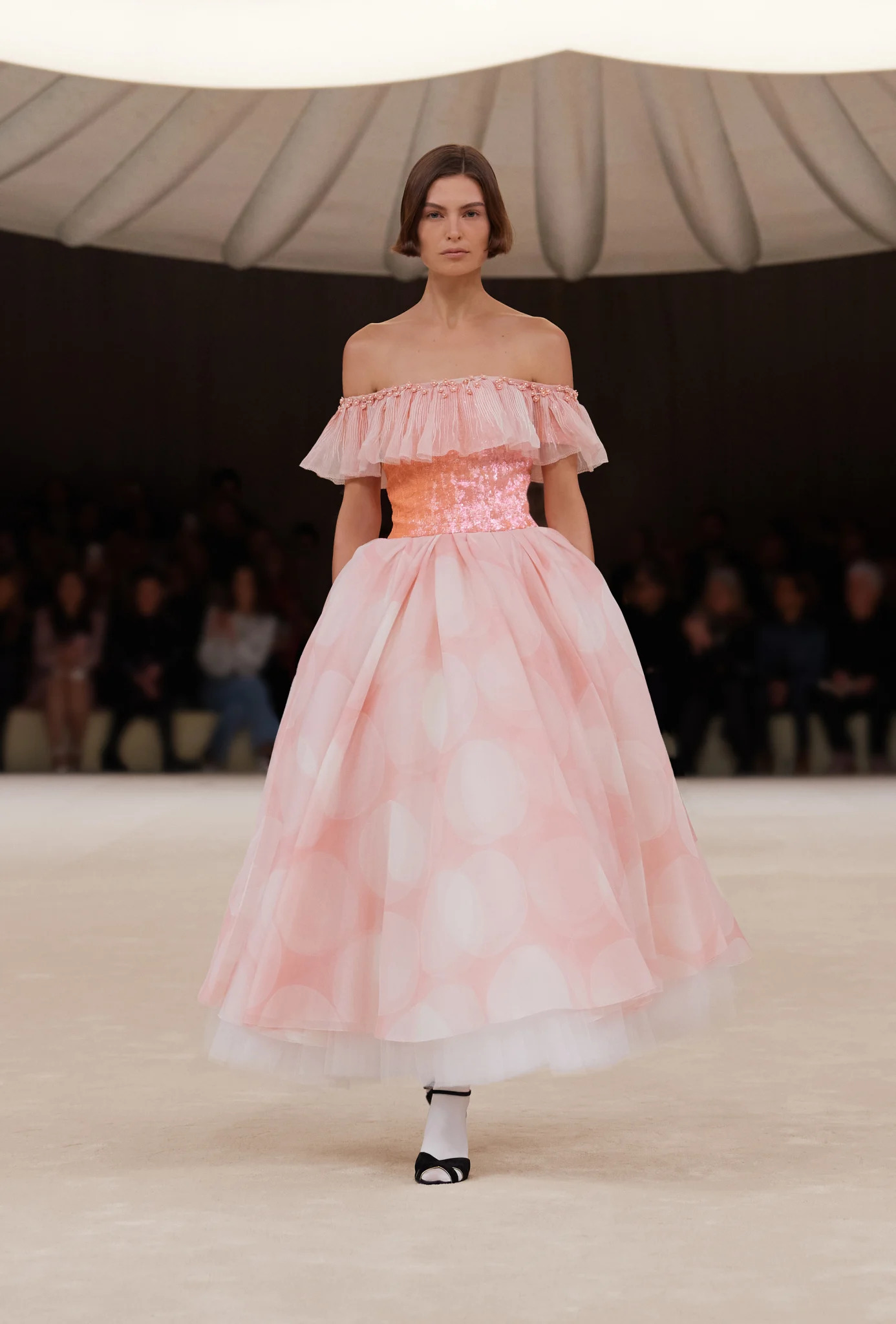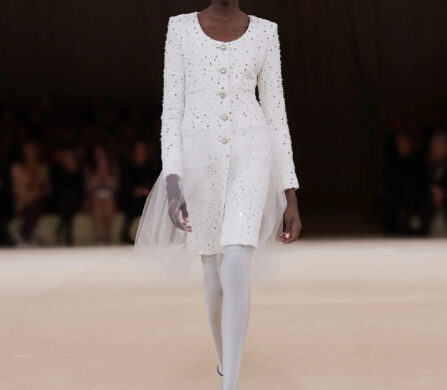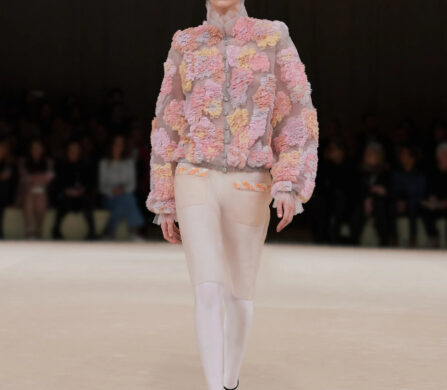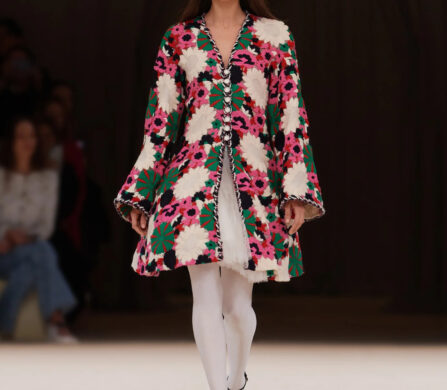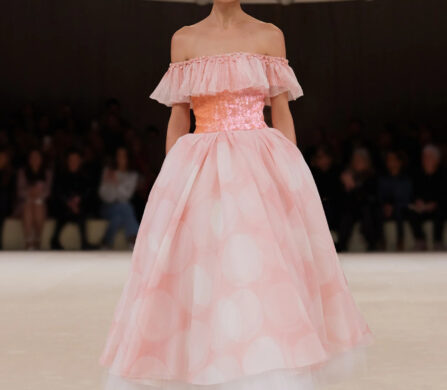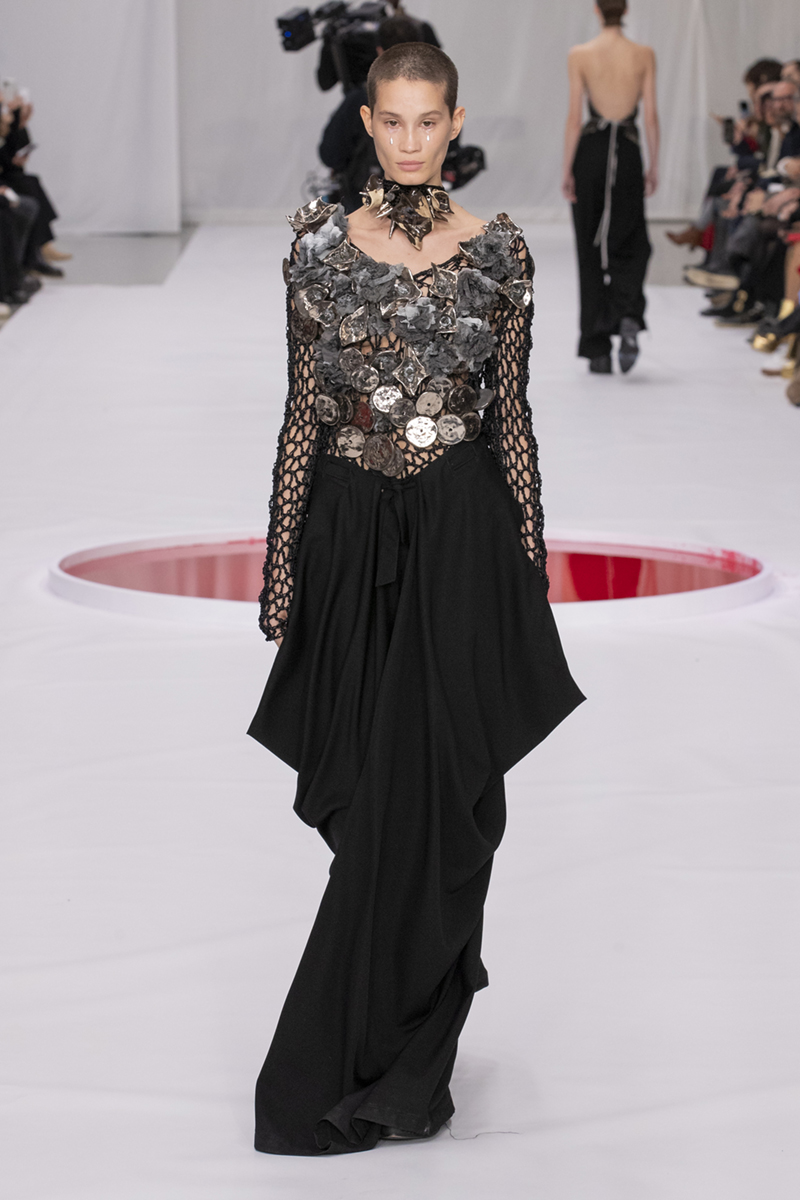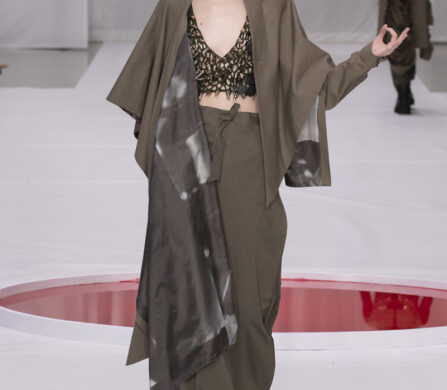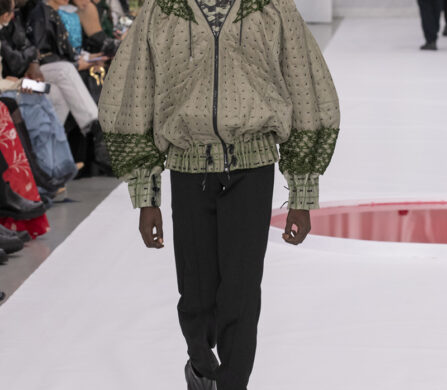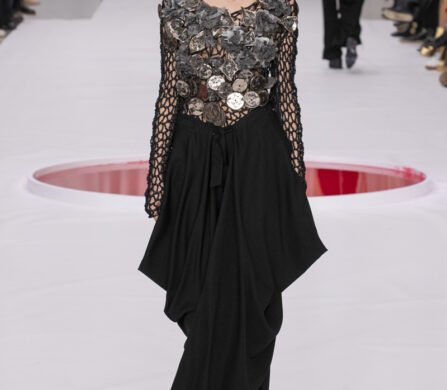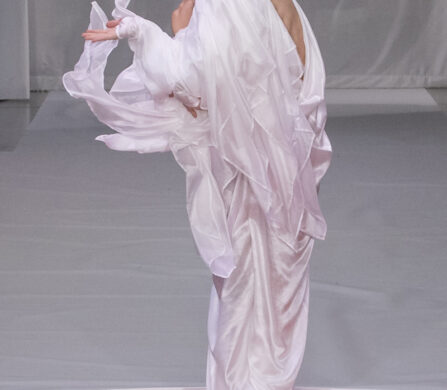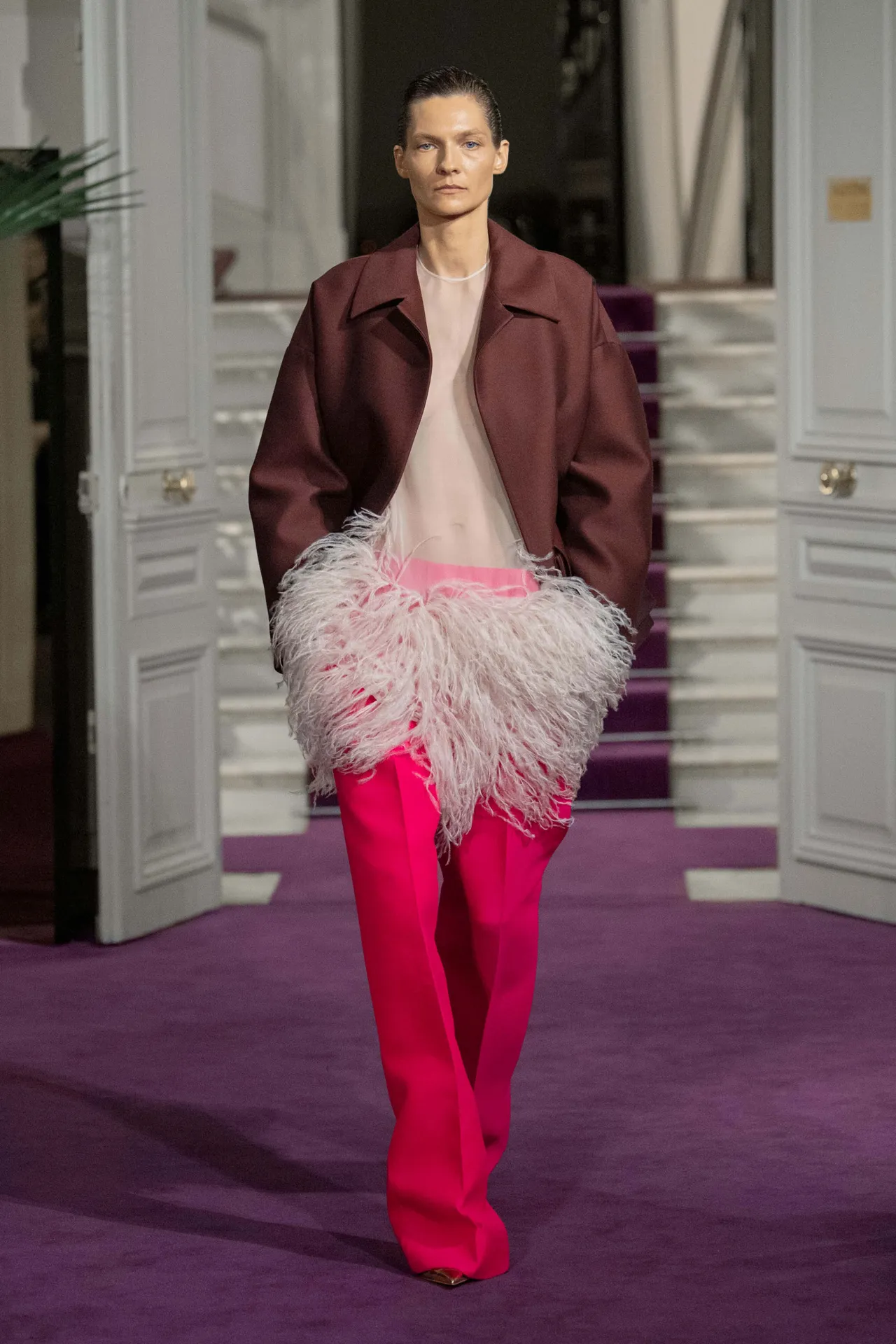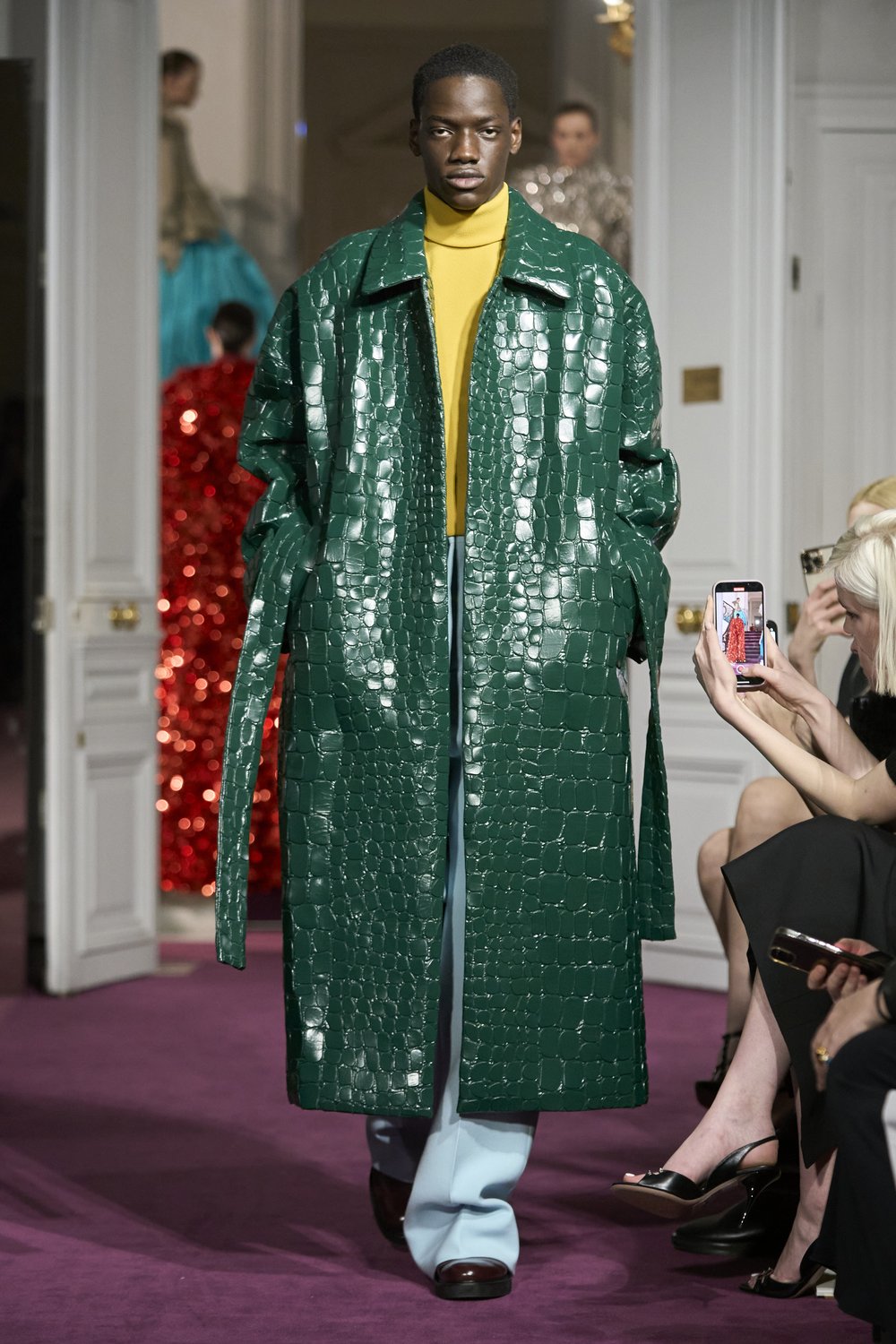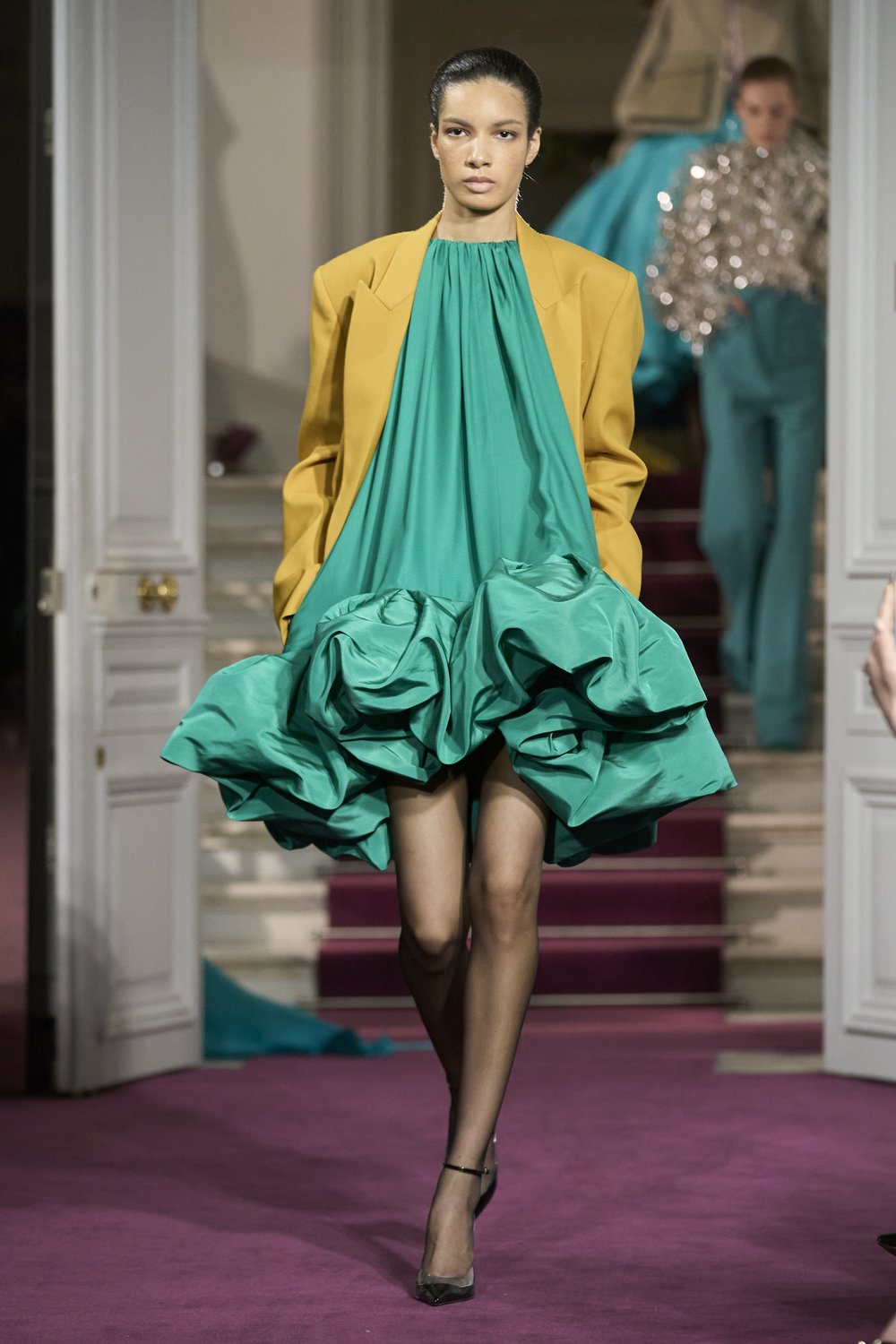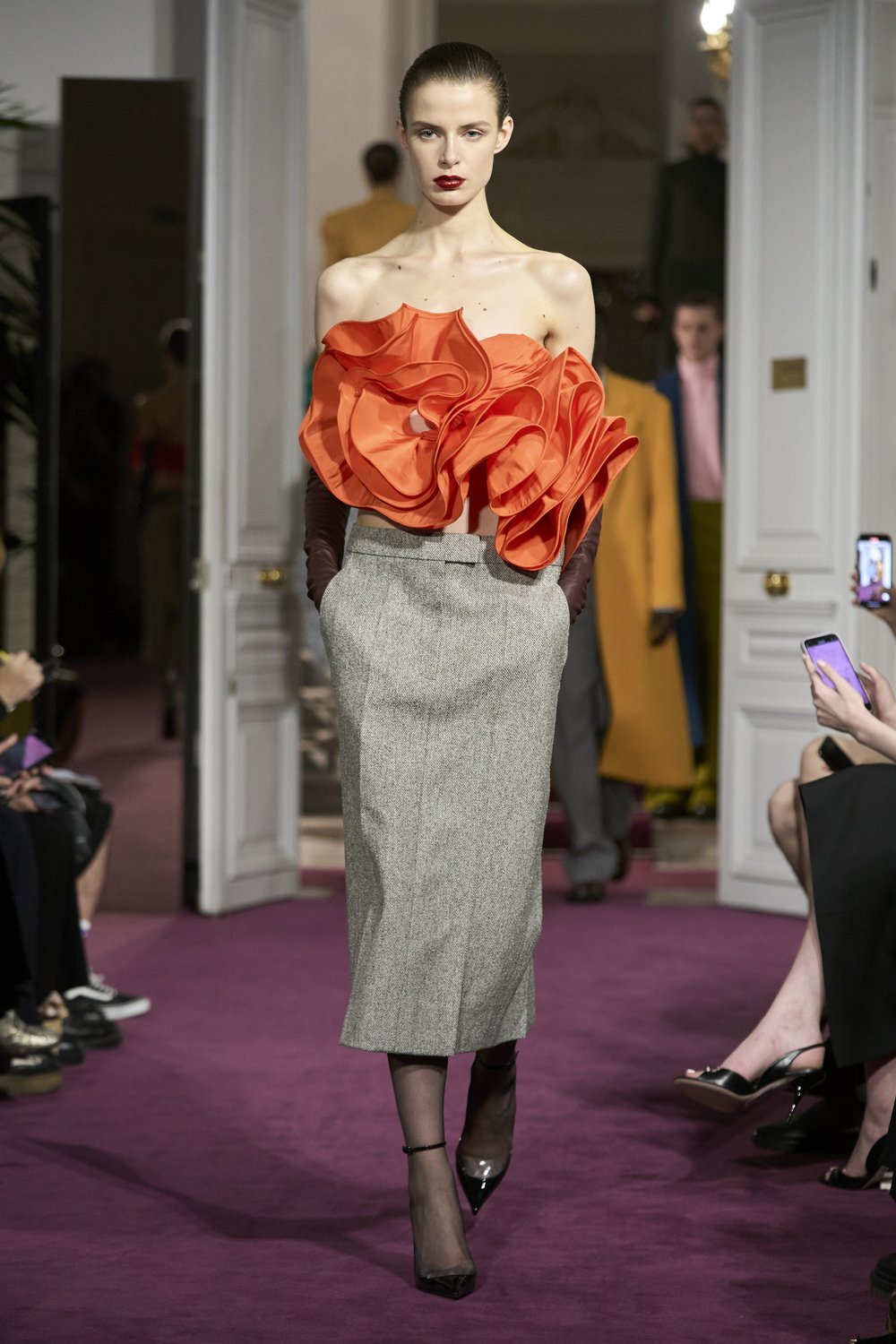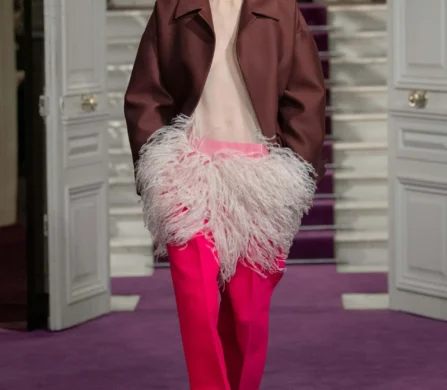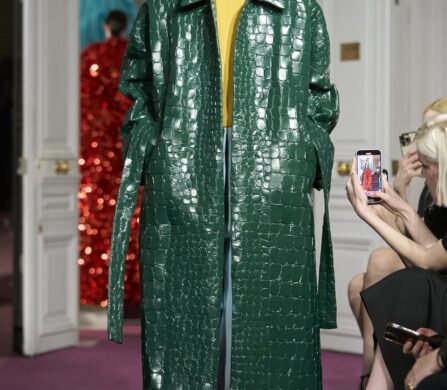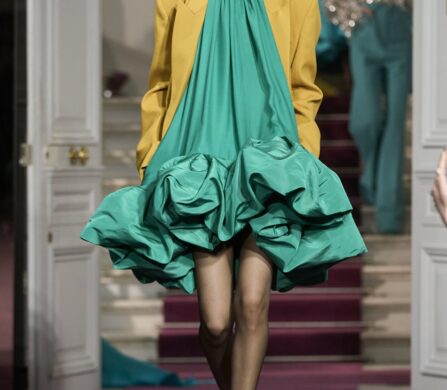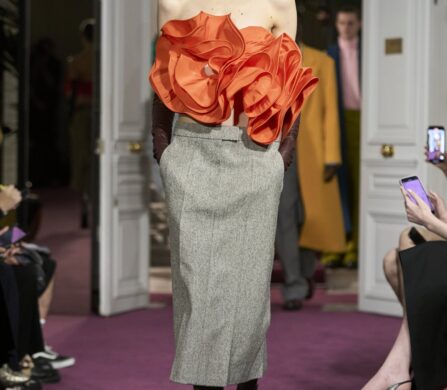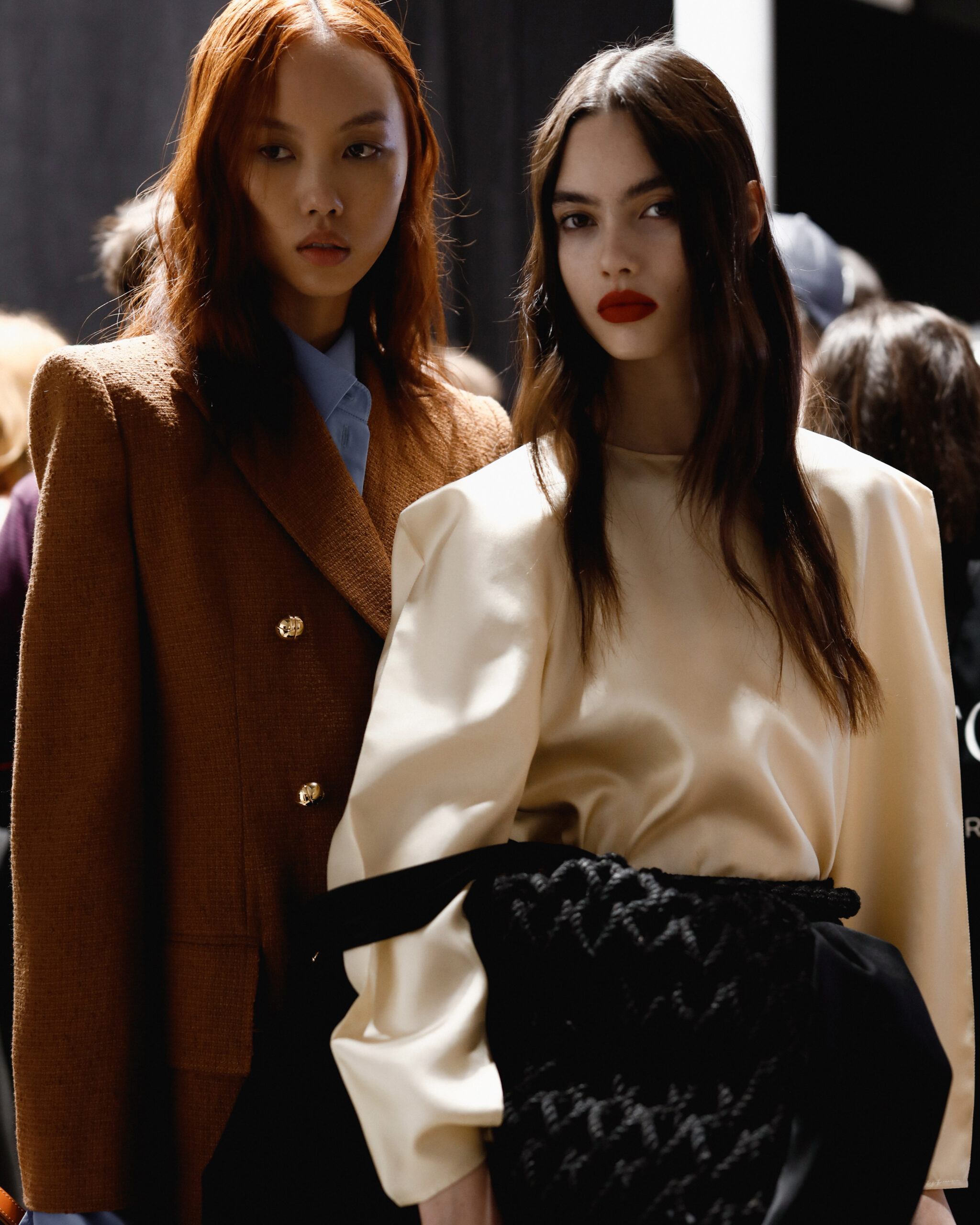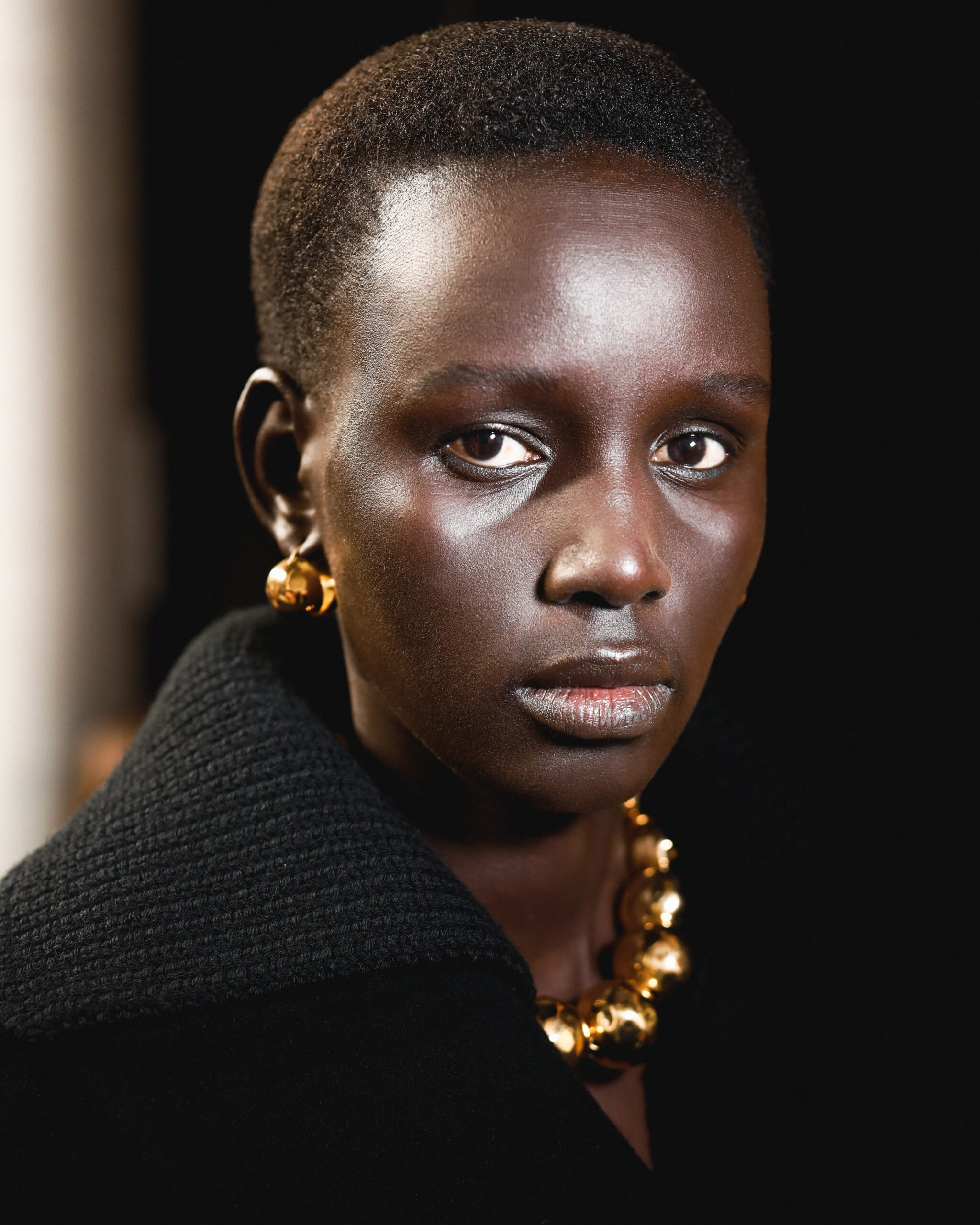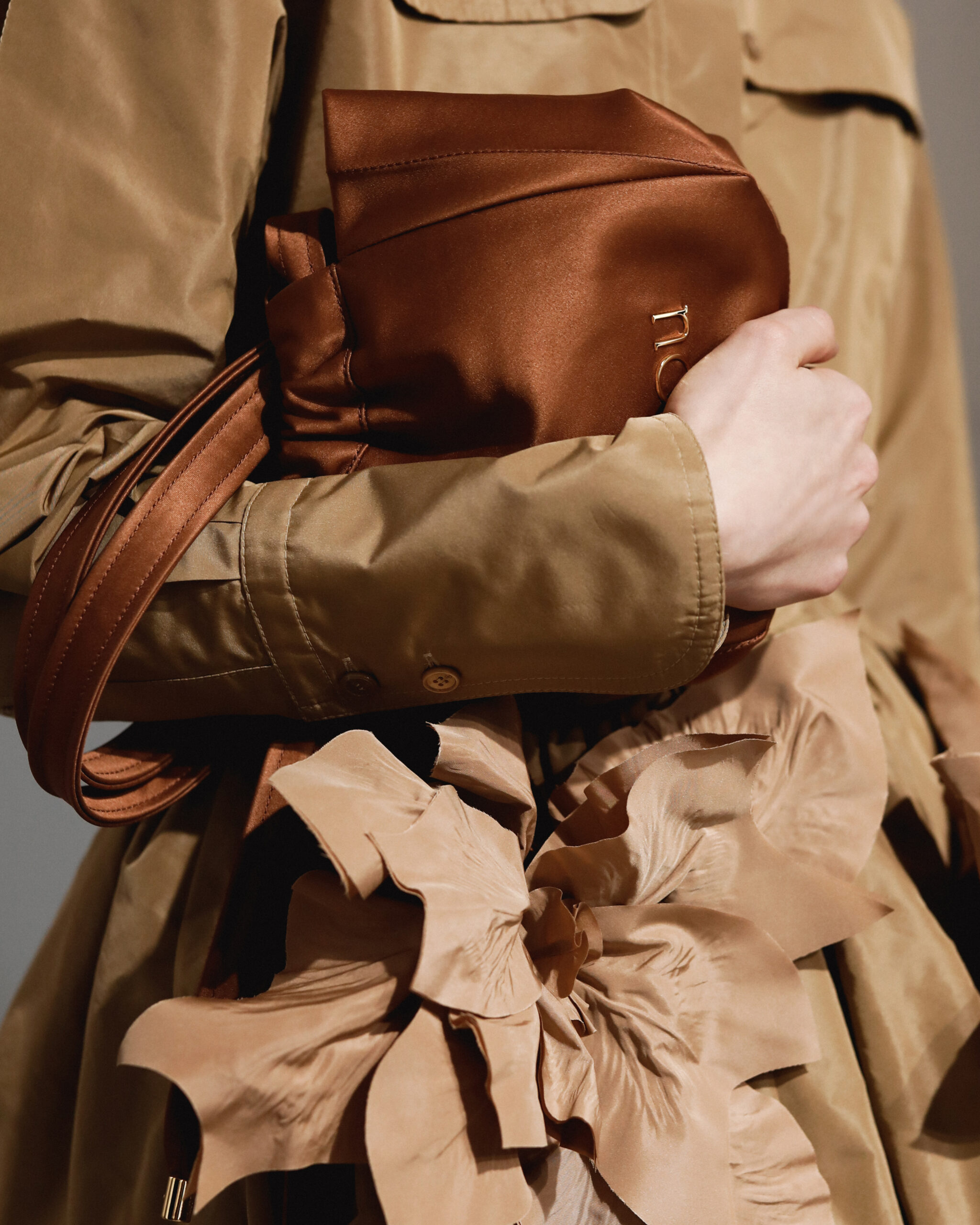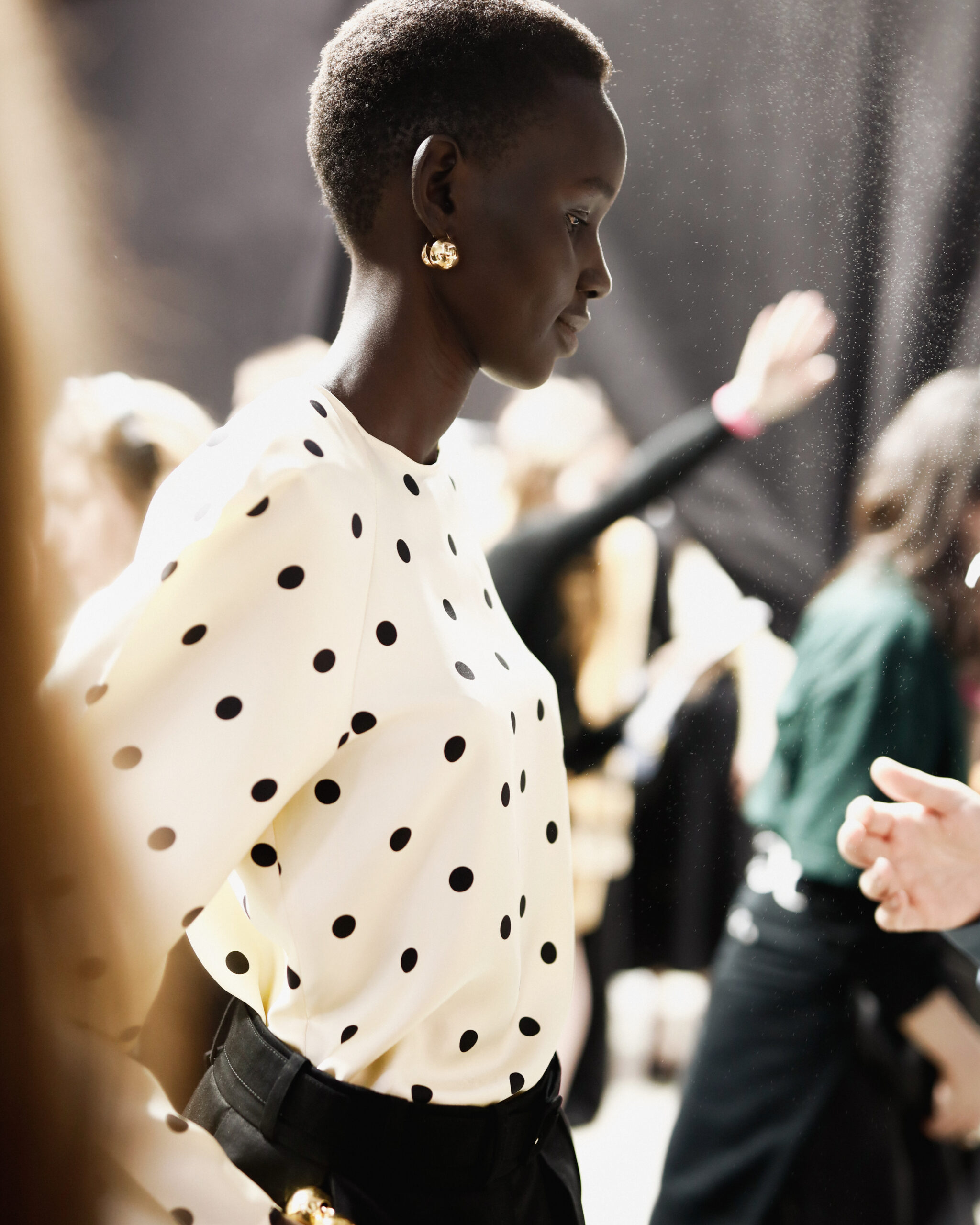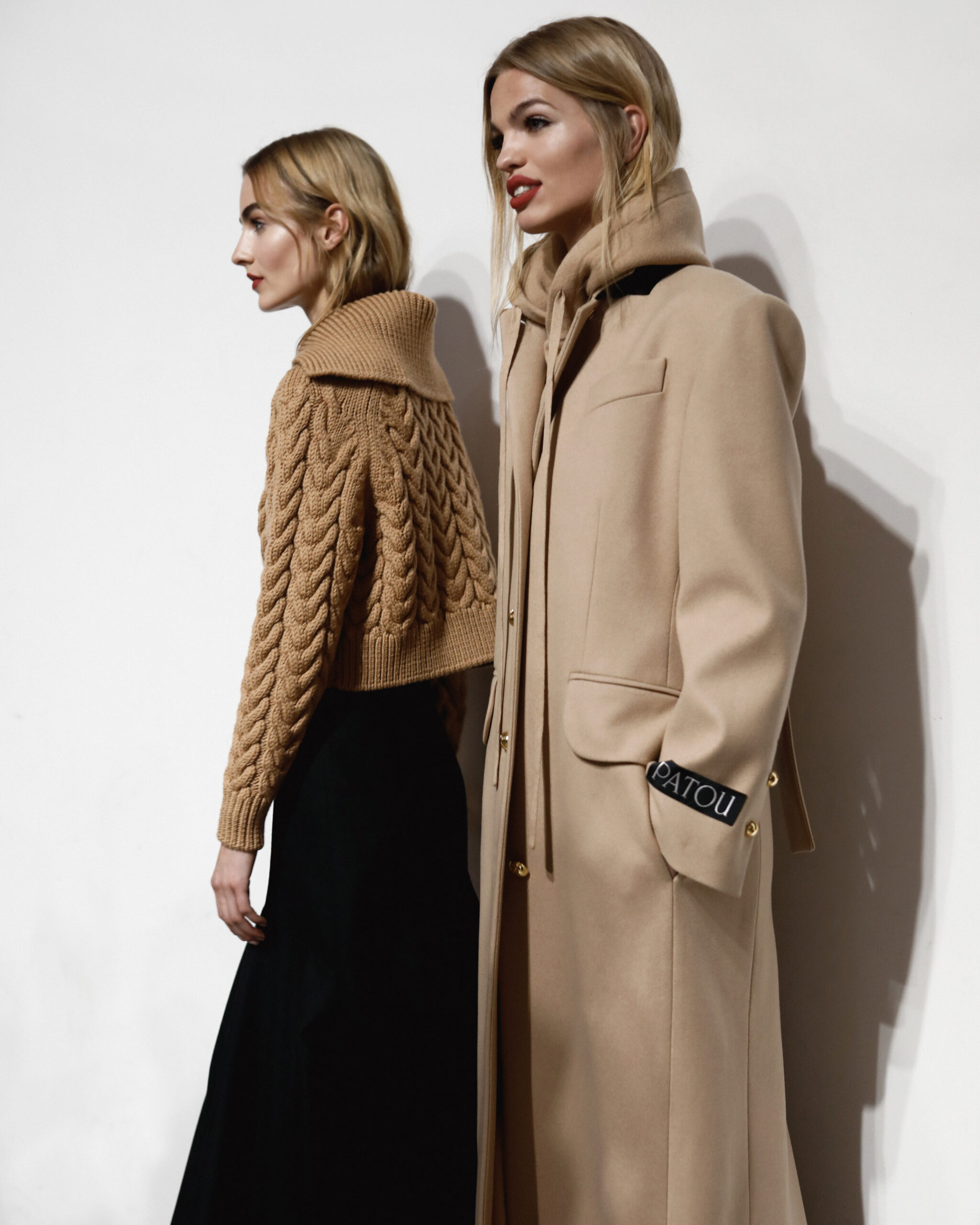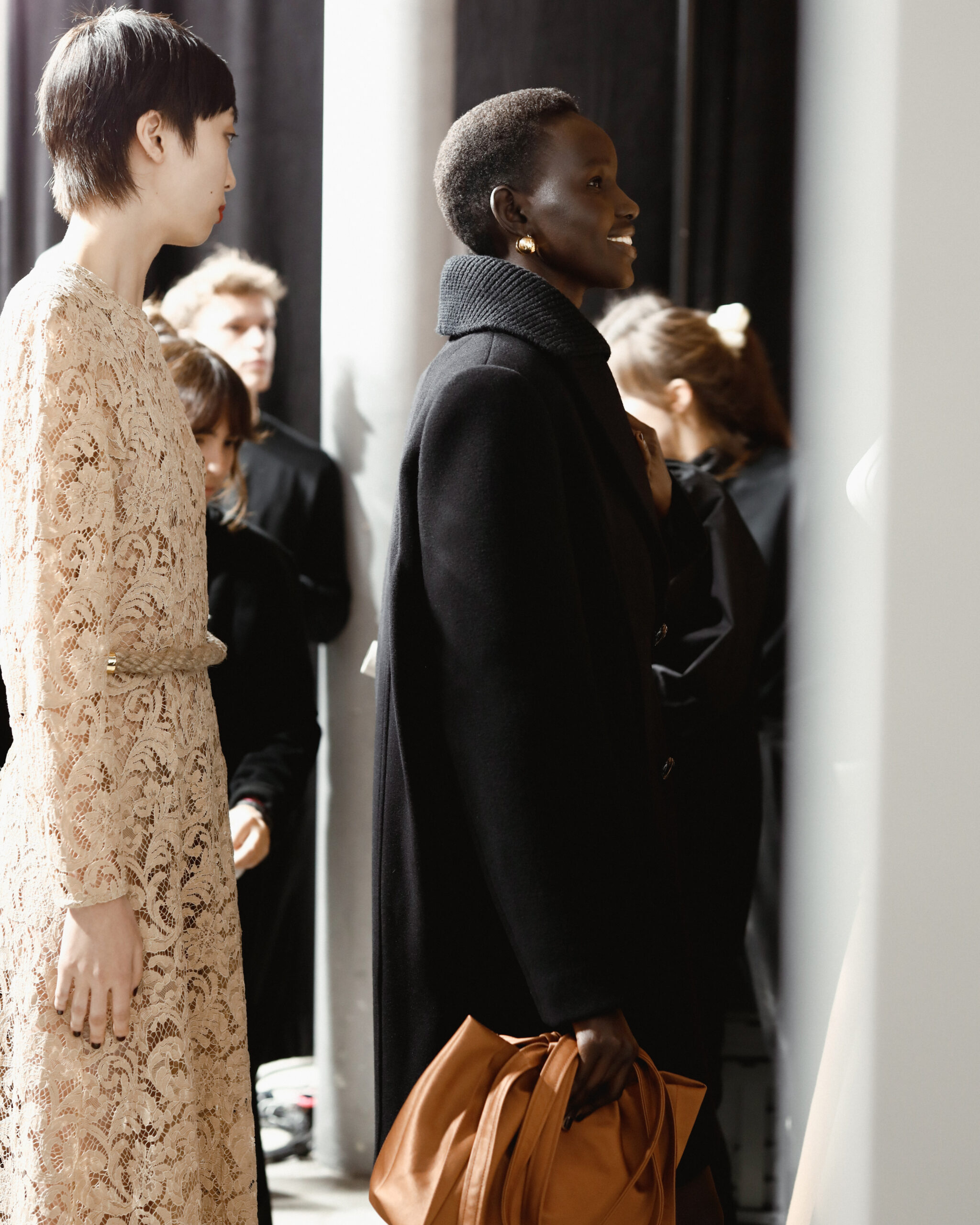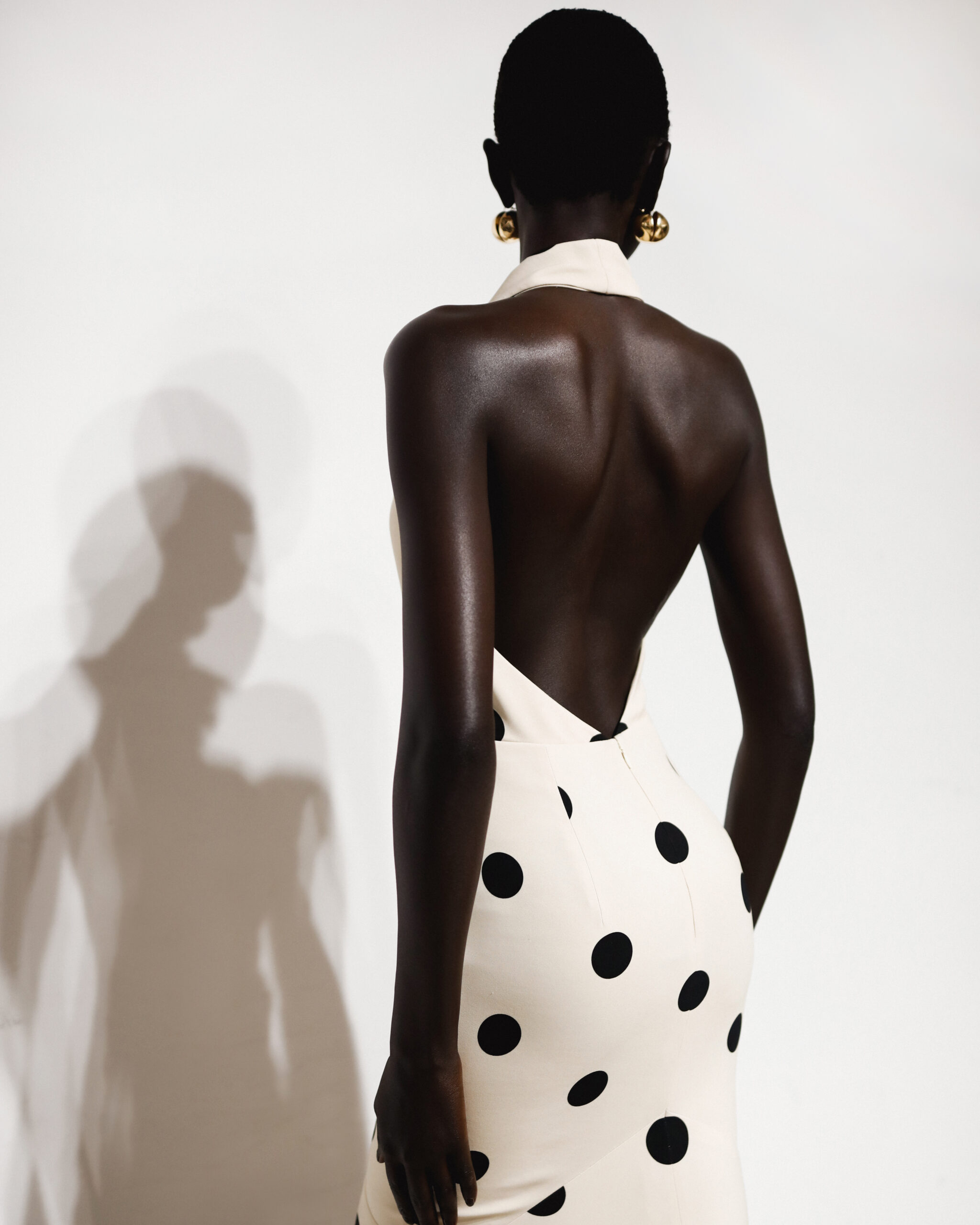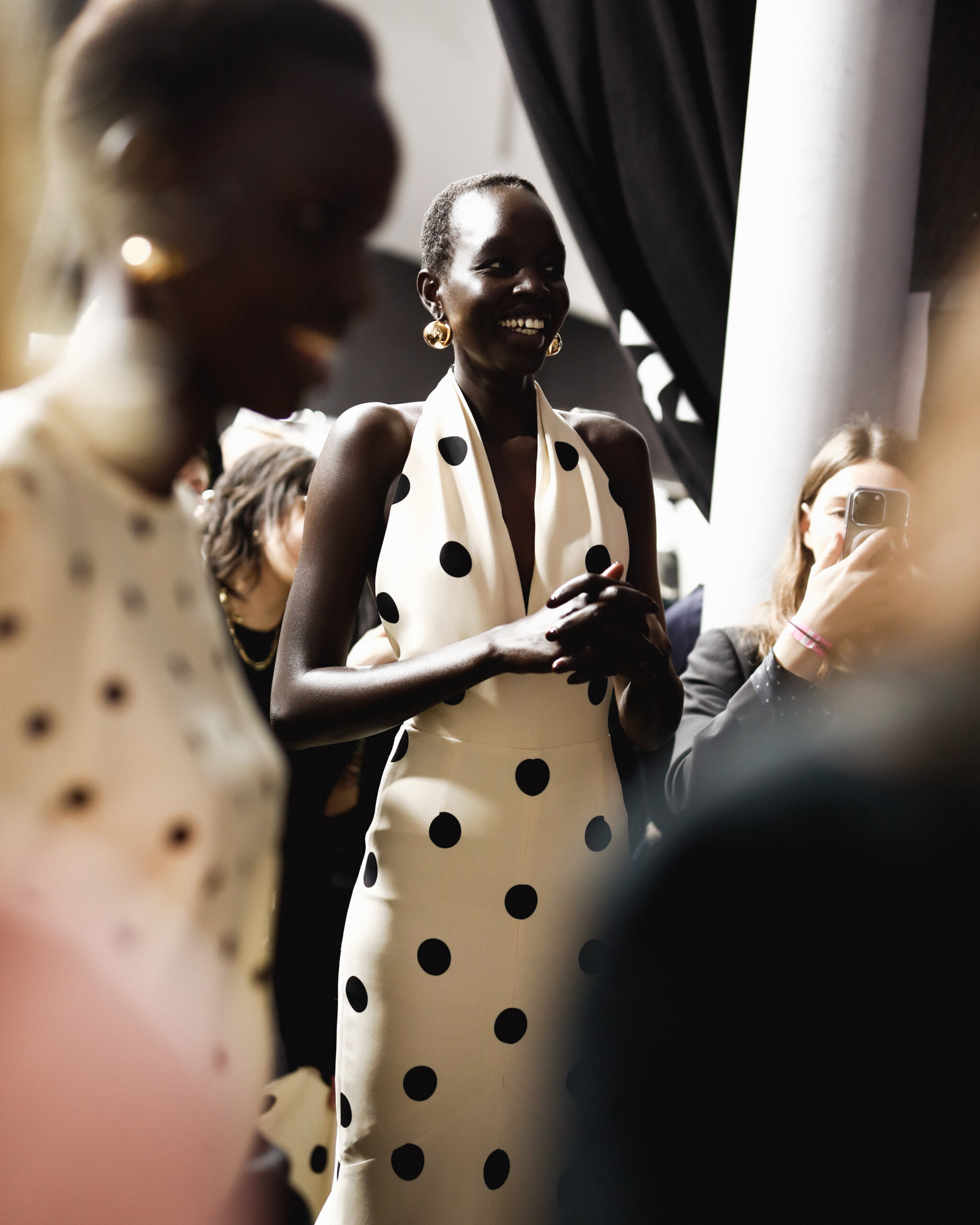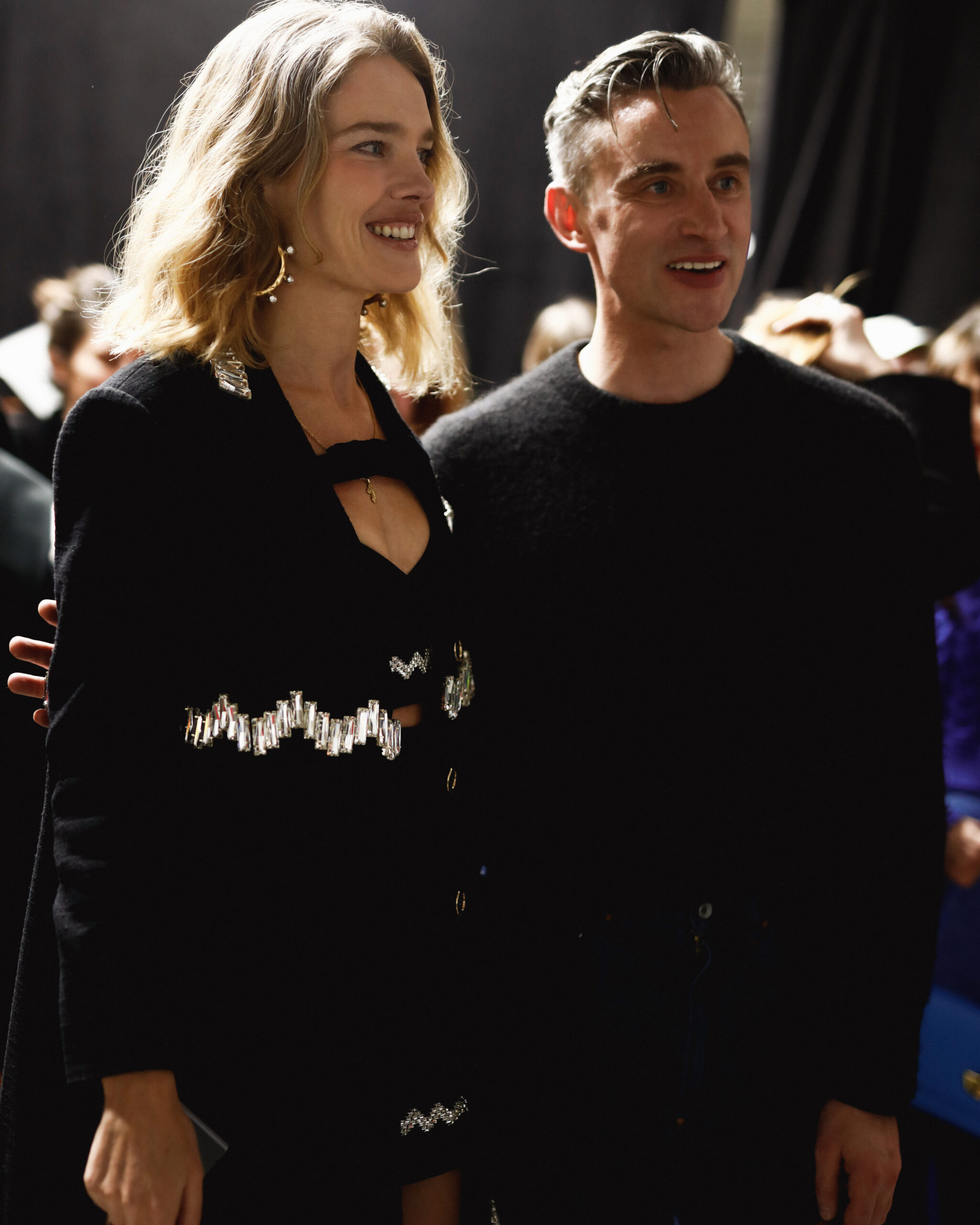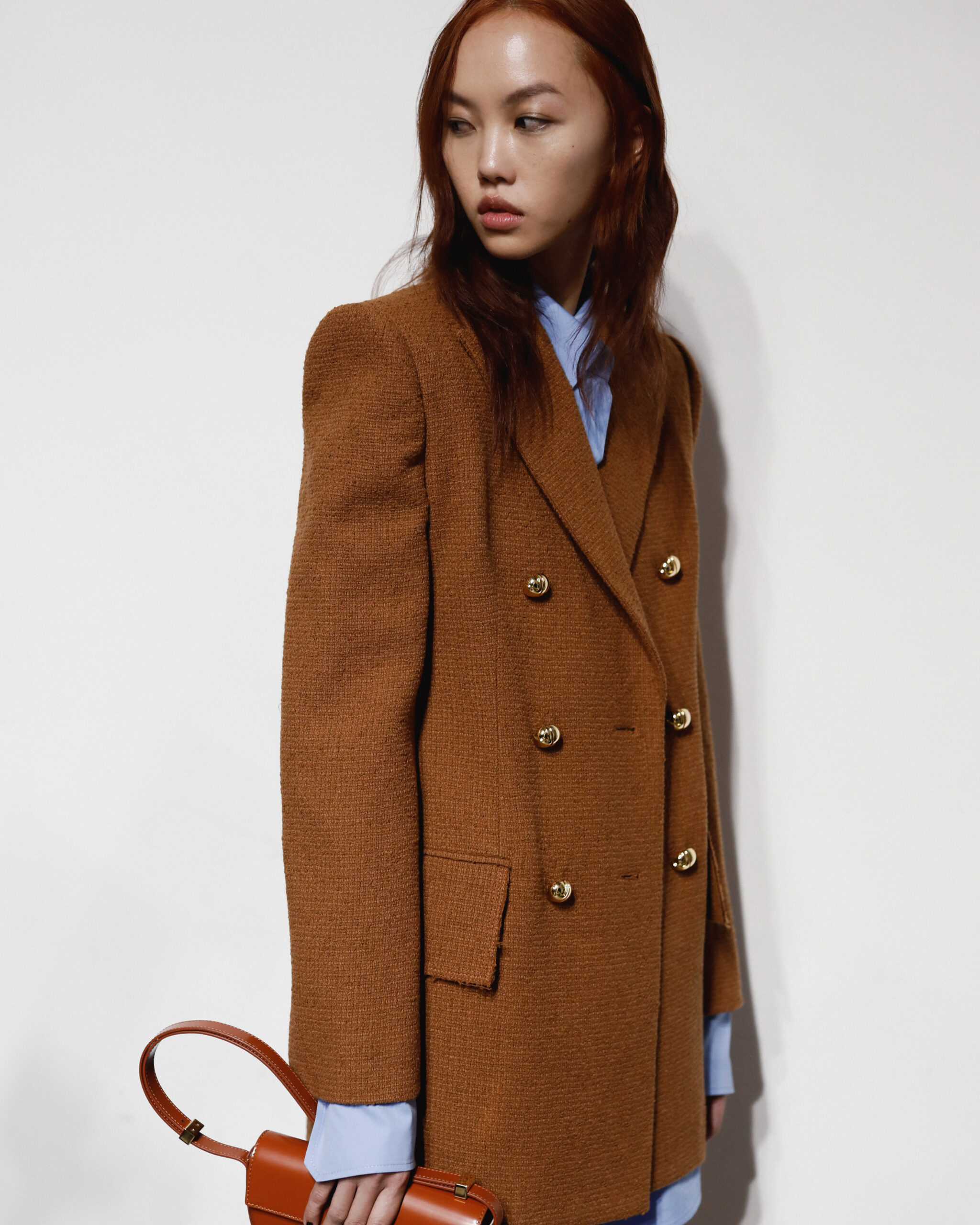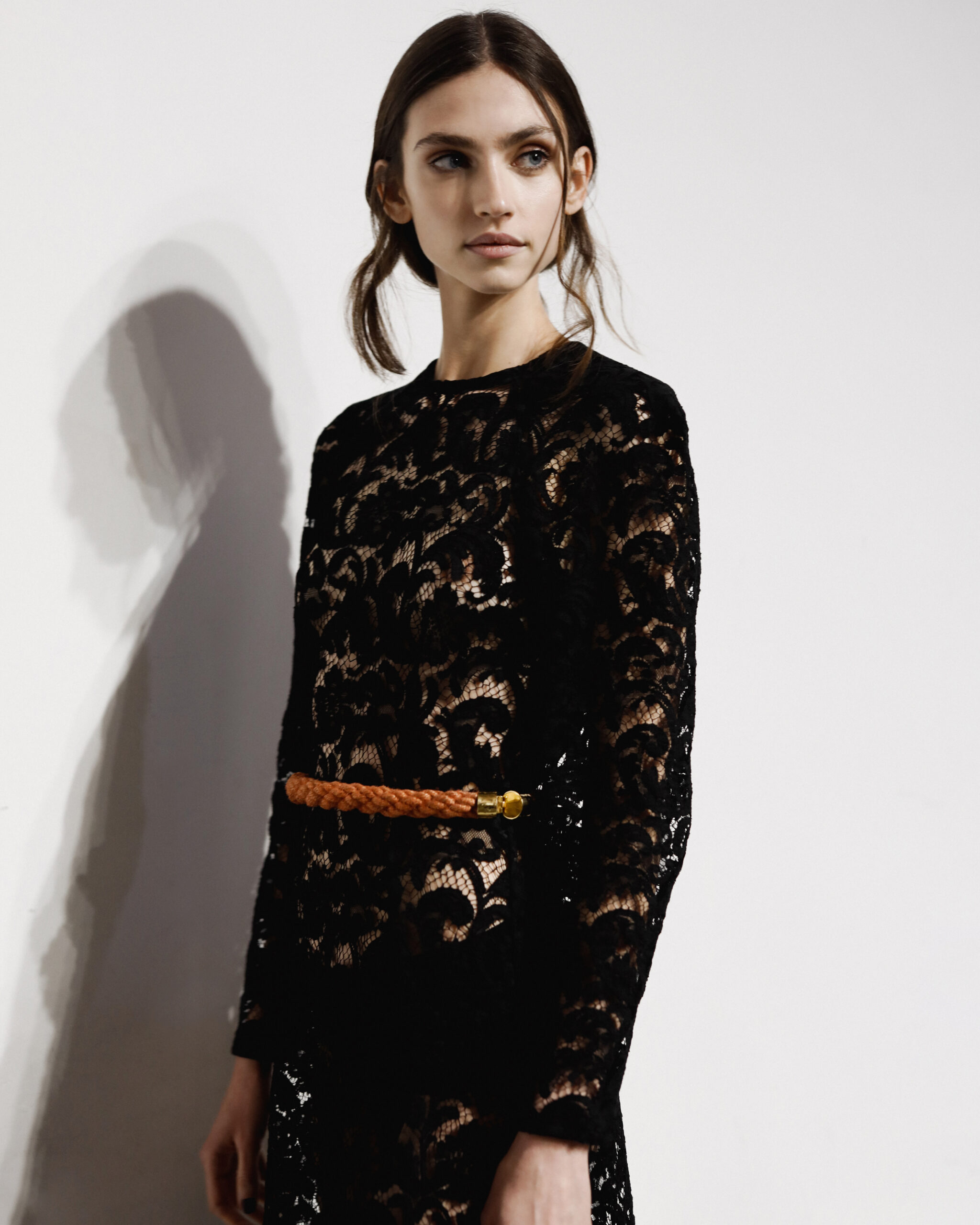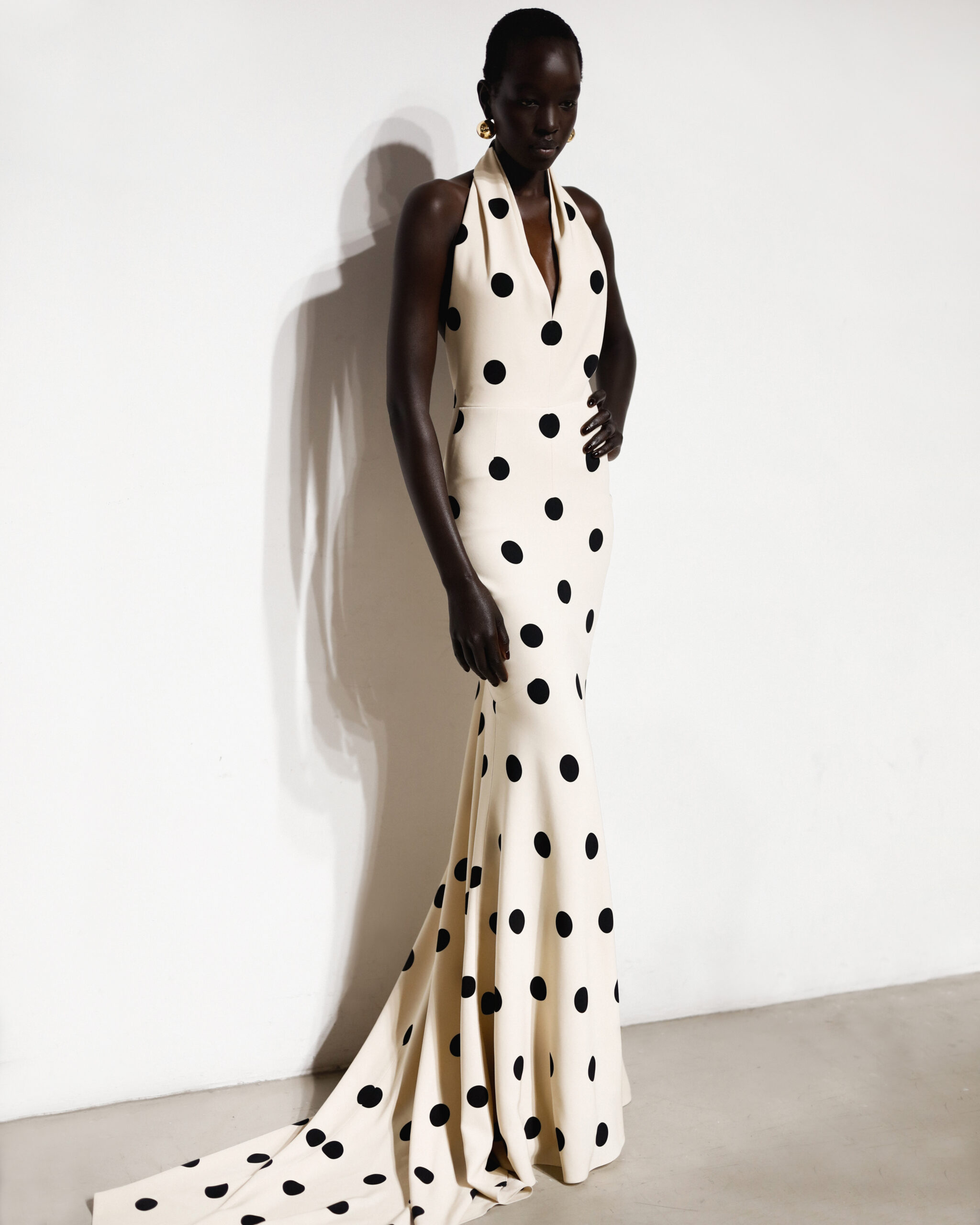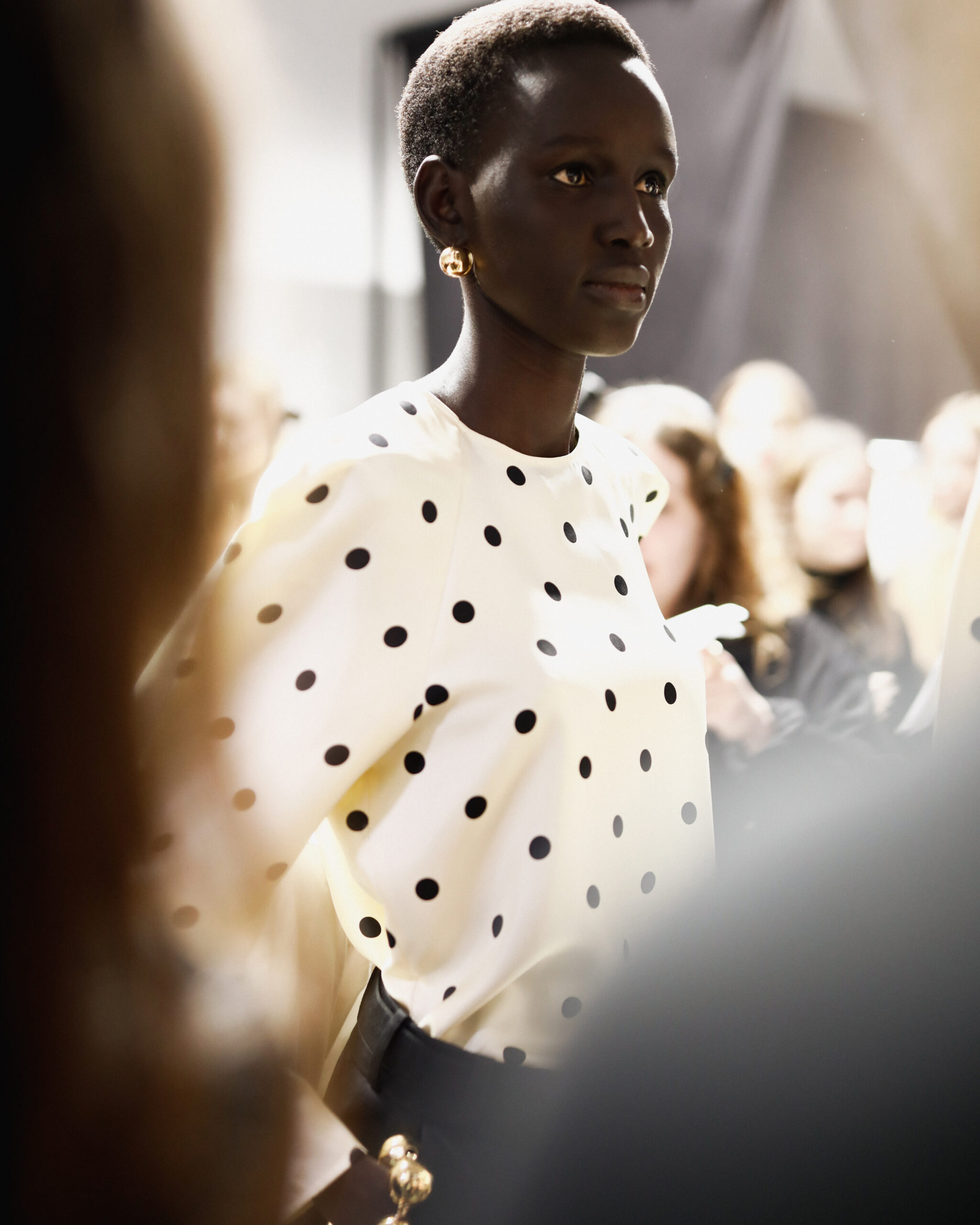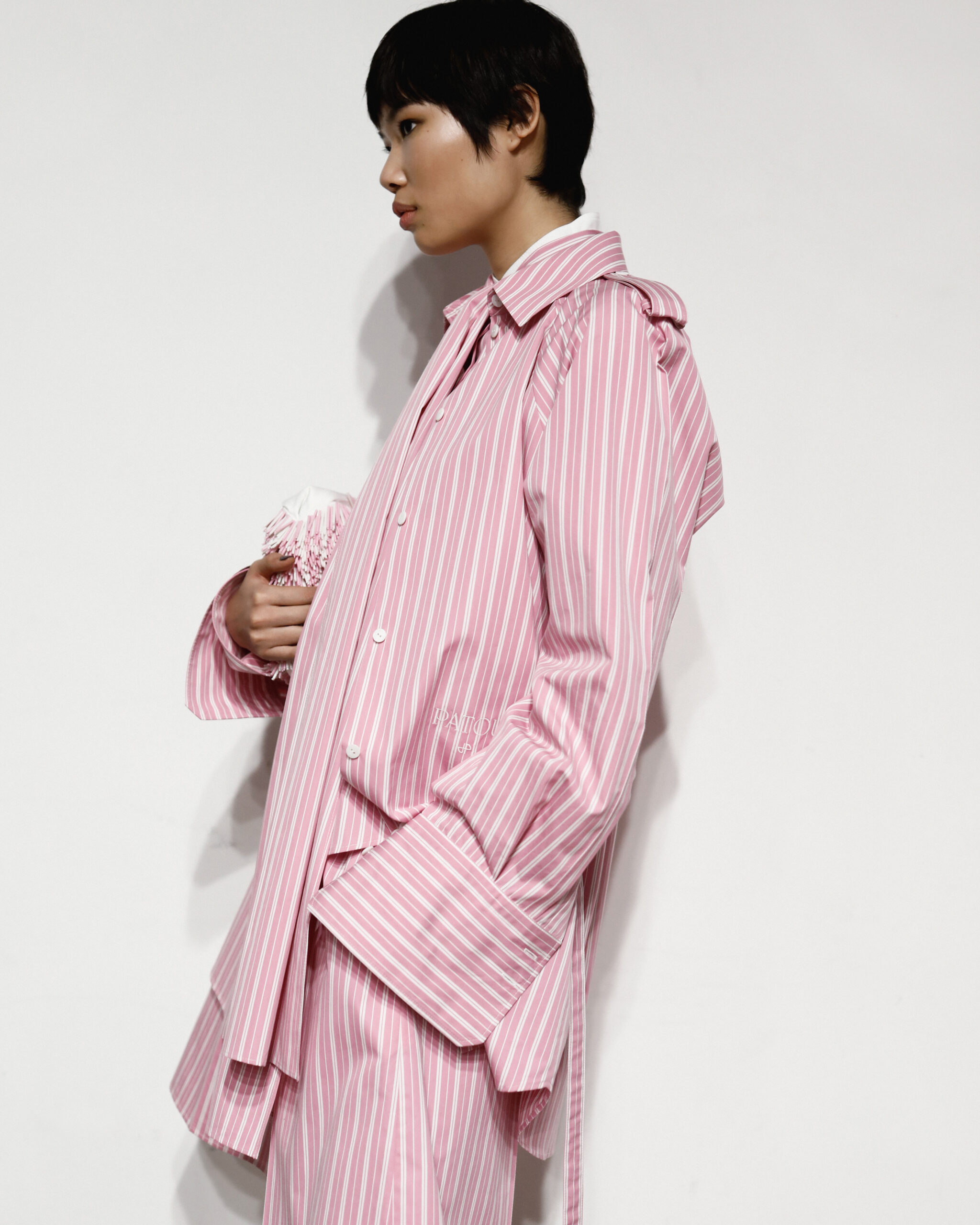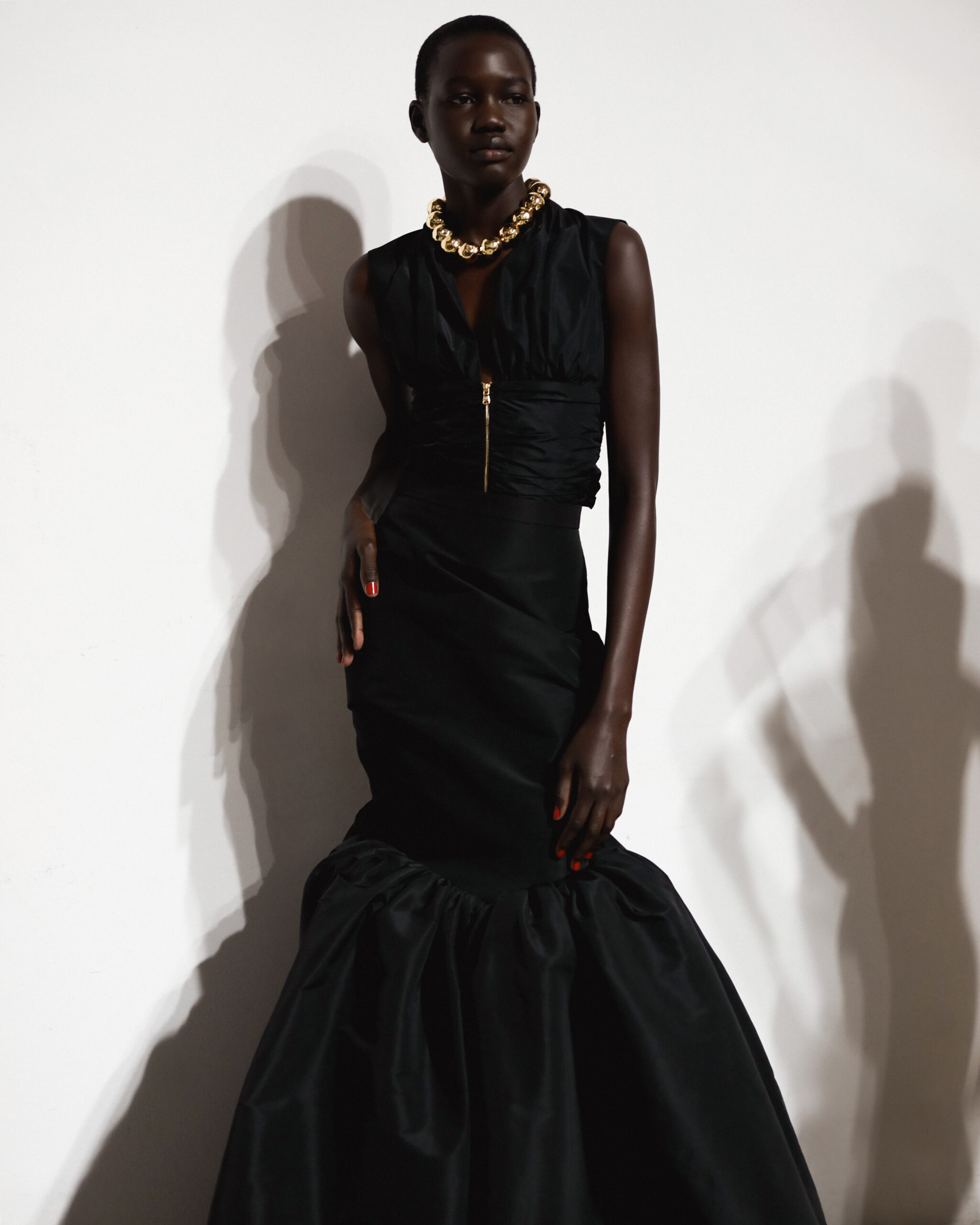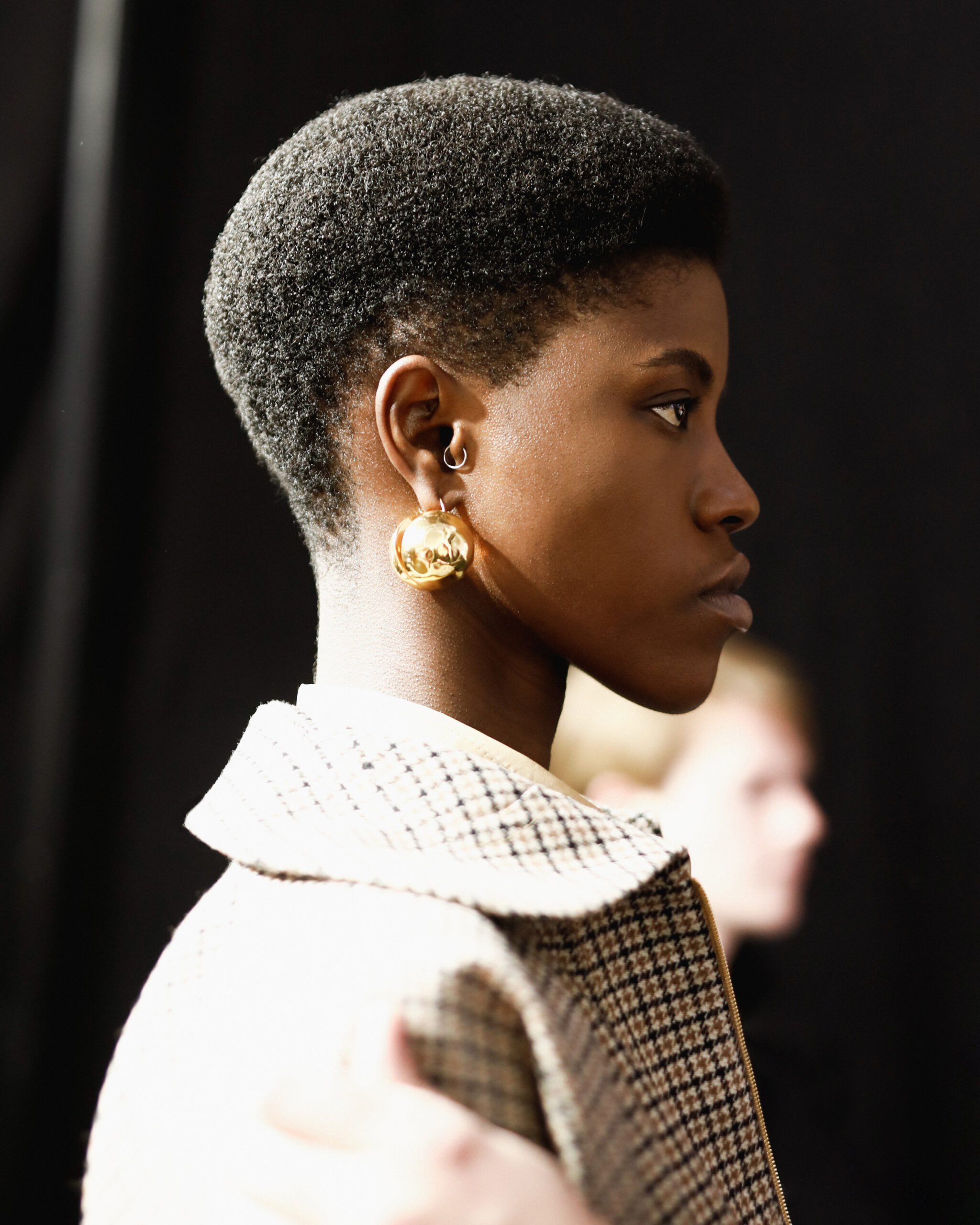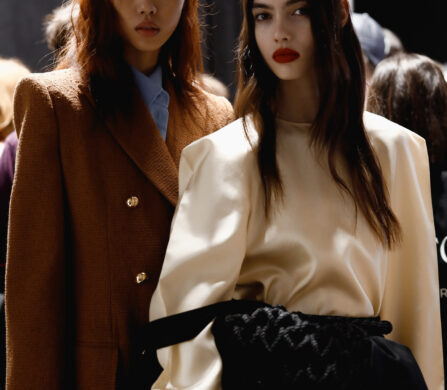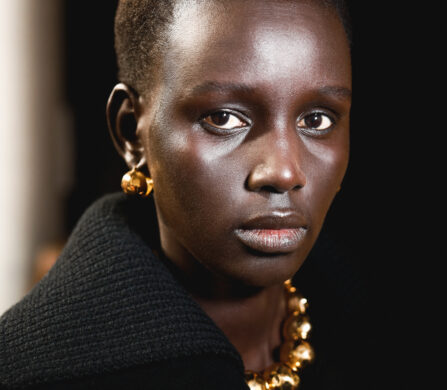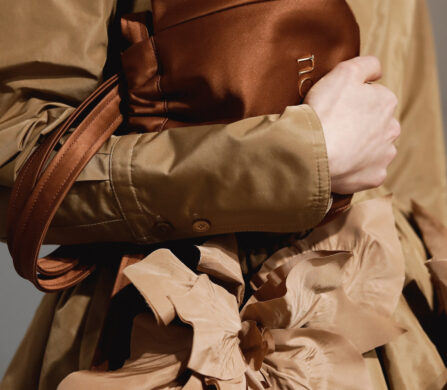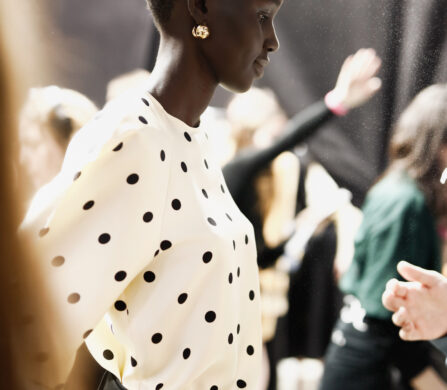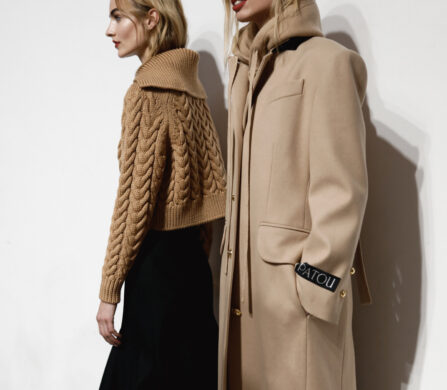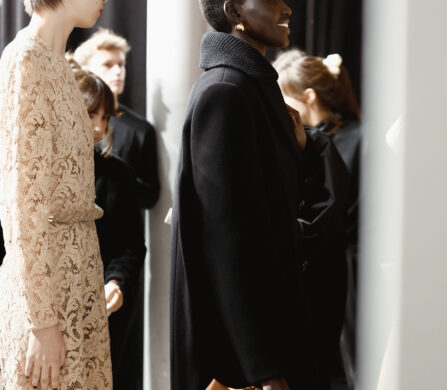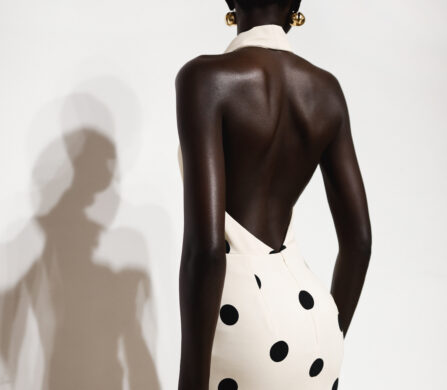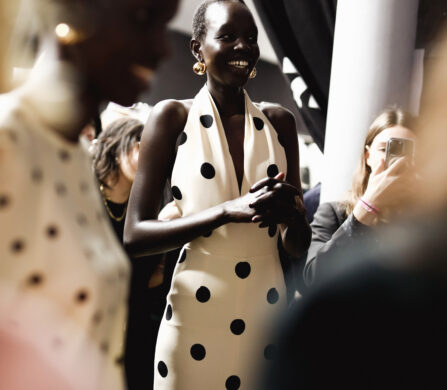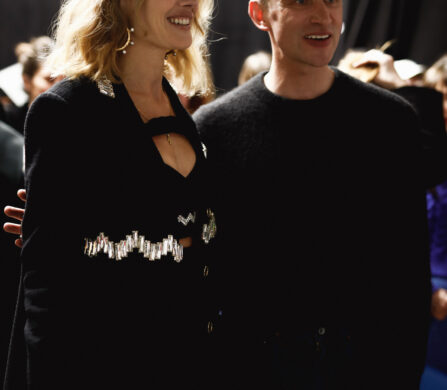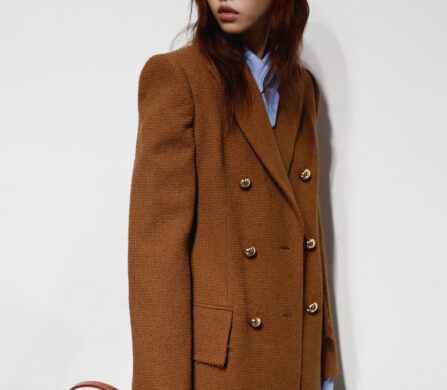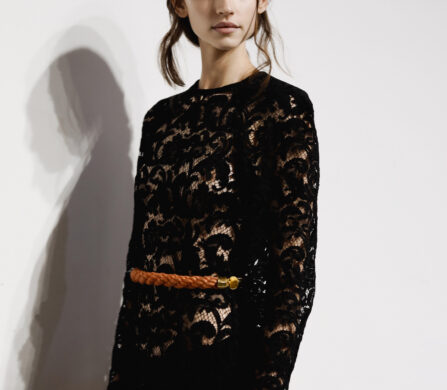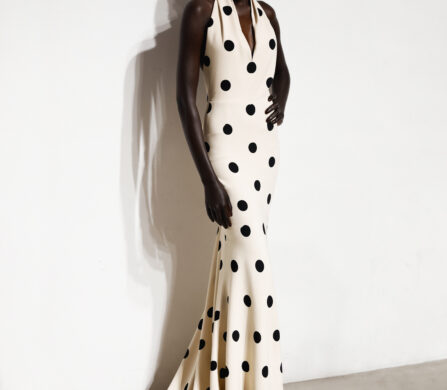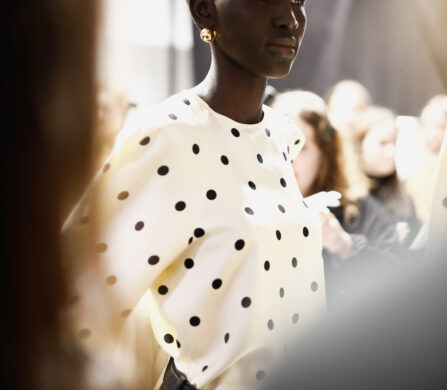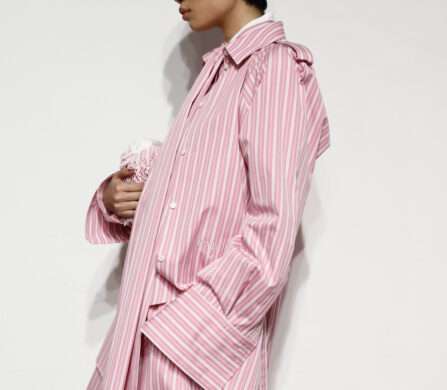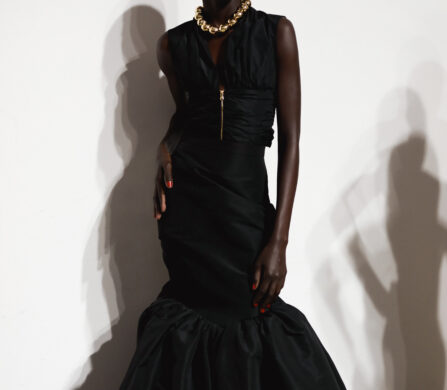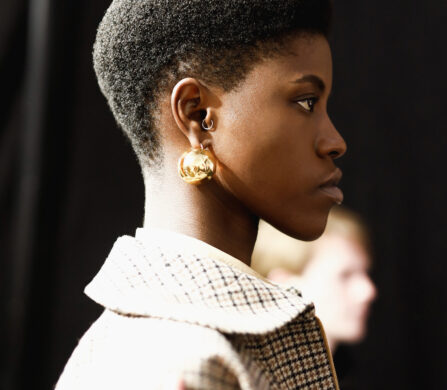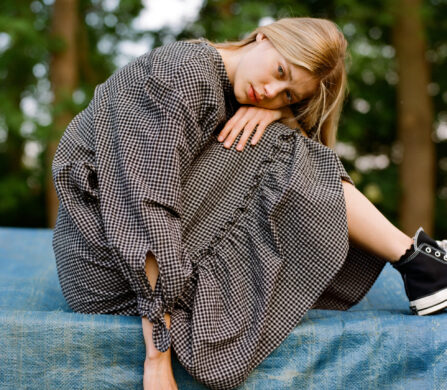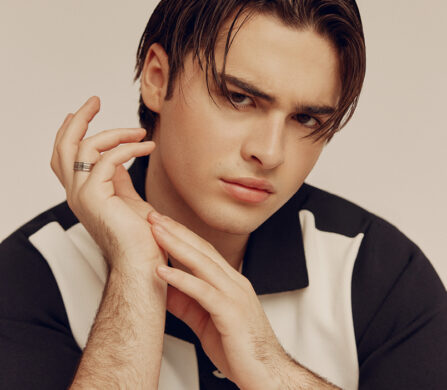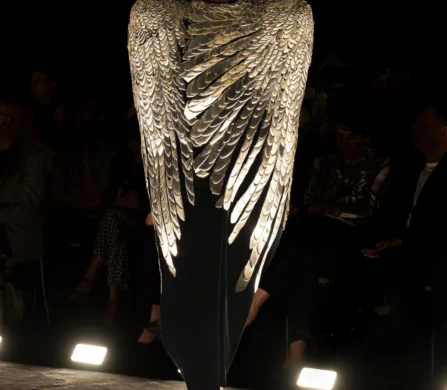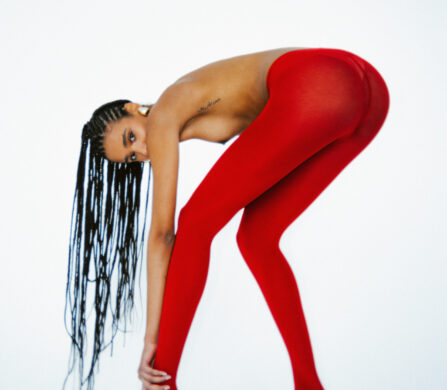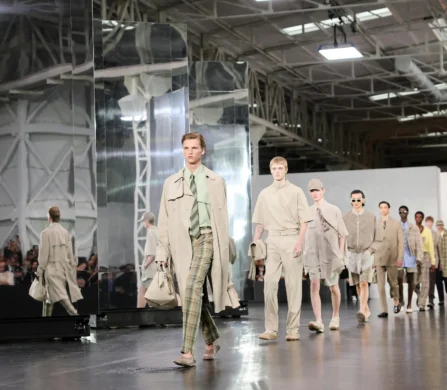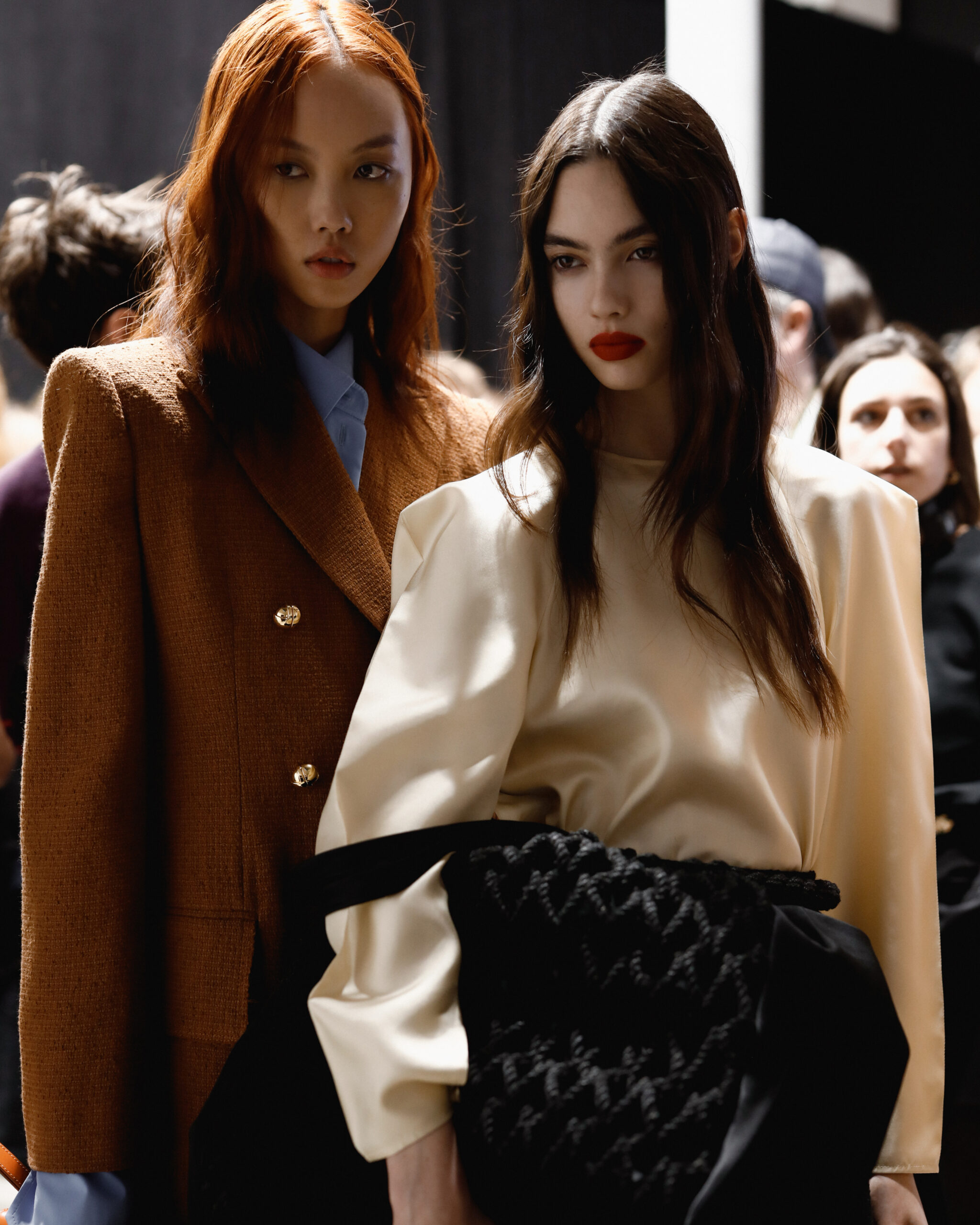
Paris Haute Couture was once considered endangered, possibly obsolete, and certainly, beyond two or three names, hardly worth reporting. This season, alongside thirty-plus official shows, there were many off-schedule shows, installations and opportunities to see more collections, almost doubling that number. The cultural span of designers embraced Morocco, Lebanon, Cameroon, Italy, France, China, Japan, and more, demonstrating how the wallflower of fashion has become a rose.
Dive into Schön!’s first impressions of the shows, and although many readers will have already watched their favourites, but perhaps we can encourage you to venture further.
Schiaparelli
The sheer bravado with which Daniel Roseberry attacks each collection is a pleasure to witness. His clear delight in what he, and the Schiaparelli ateliers, can conjure up is very apparent. However, the real test of much of couture is seeing the work close up, and having time to examine the details and with Roseberry this is so worthwhile. The “pin” holding the collar of a white shirt is actually a Schiaparelli pencil, the bandana effect patterns are densely beaded, and the graded effect of shells is actually several different types of shell. Spending time at the Place Vendome headquarters, in conjunction with seeing the show is the perfect way to really focus on couture. This season it seems as if other planets and other life forms, alongside a stomping and whirling rodeo, were the two axes the collection was inspired by.
There was much asymmetry in both moods, and his use of silhouette remains truly innovative, with soaring shapes and exaggerations, such as towering extensions in lace or satin and plunging sleeves and fringes. Confident, focused and clearly in love with his job, Roseberry can draw, create, work on the model, drape fabric and envisage a complete collection. The true designer, yet also humble enough to allow the atelier to reproduce exactly an original Elsa Schiaparelli 1949 design for Carey Mulligan to wear at the Golden Globes Emmy’s, without altering or putting his mark on it.
Imane Ayissi
Combining the power of traditional couture with a cultural background growing up in Cameroons has resulted in a certain unique signature for the designer. The flamboyance of draped robes transforms into a couture evening dress, the formal geometric weave of a traditional African textile is in perfect harmony with clean-lined urban tailoring, the swagger of raffia fringe combines with silk in creating cocktail drama, and tiny hand-made rosettes in body-hugging asymmetry contrasts against flowing drape. The models trailed panels of vivid silks through the rooms or twisted as airy drapes ballooned behind them, or they simply strode through the room radiating confidence. It’s as though the great couture images of Avedon and Penn have been brought into the twenty-first century but each time with a twist, a little more leg showing, or a startling colour. He respects the past but builds upon it neither copying nor parodying, it’s simply implicit in his creative outcomes.
George Hobeika
The collection celebrated Arab culture through so many facets, from architecture to textiles and interiors, traditional dress silhouettes, Arabic colours and the decorative arts in general. Its vibrancy and visual impact were the result of confident ideas, a personal knowledge of the culture and its reference points, and a desire to offer clients something specific, focused and true. The ombré effects on lattice embroideries, the jewelled gloves, and the sharp clean lines of tailoring juxtaposed against fluid drape told a story of creative focus. The collection offered facets and options, whilst maintaining this focus. The colours were shifting from pale pistachio and lavender to vibrant scarlet and celestial blue, with patterns from tiles, ceramics, and architecture lending themselves perfectly to a vision of couture.
Dior
Maria Grazia Chiuri had clearly looked at La Cigale autumn/winter 1952/53 by Christian Dior as a wonderful example of moire. Moire was one of the key themes pointed up in press releases for the collection. There was a distinct feeling for 1950s couture details in the show, with portrait collars, softly twisted details and swinging and swishing skirts. Add to this some romantic blouse looks, yet Chiuri never allowed the collection or any piece within the collection to become over fussy, pretty or elaborate. The daywear especially is subtle and discrete with neat tailoring, soft wide trousers, neat but not overfitted jackets and an ease to it, pitching modern couture to a modern client. Colour was used sparingly but the collection felt light, summery and balanced, urban, rural and resort in equal measures offering clients a summer wardrobe of Dior to take them through every occasion and situation from business meetings to picnics. Exactly what Monsieur Dior himself always provided in his collection; clever.
Rahul Mishra
Nature, the natural world and the wonder of creatures inspire Rahul Mishra. His origins from outside a huge metropolis may have an influence, but India and the myriad creatures found there would fascinate anyone. His embroiderers and artisan workers, rise to the most extraordinary challenges each season, and if this time we couldn’t see men actually creating a tiny portion of the work, we could marvel at shimmering insects, buzzing bees, and undulating sea creatures as they stalked the runway. The balance between film premiere gowns and sharp trouser suits, long trailing skirts and short snappy high hemlines offered a wide choice for the clients, but all with his imprint upon them. Haute Couture suits Rahul, but he also knows that variety is required both to balance a collection and to satisfy sales. The more restrained and the less statement is as important within the collection as the gala or extravaganza looks, it’s about balance, as nature itself understands so well.
Maison Sara Chraibi
Since her very first collection Sara Chraibi has shown her inspiration, and her emotional pull is to her heritage and cultural background. It is couture with its heart merging North Africa, Morocco, and Paris, crafts of her homeland reinterpreted through the lens of haute couture. This season the colour palette was brilliant using both the desert, rock, architecture and building material shades but also, oasis vegetation and spice tones, the colours worked across the show gradually fading into each story. The fluid predominated as a silhouette, with tailoring highlights, and liquid gold added at times. There’s a power to the women in the show, from their wonderful hair and makeup to the tips of their fingers. The robes, dresses, coats and so on flowed around, making them less catwalk models and more high priestesses. She should be asked to design for the opera since Norma or Aida should look like this. Cultural references were there in architectural imagery from Morocco’s past but most importantly this is beautiful couture fashion, with a unique creative attitude, and very desirable clothes.
Homolog – Emily Cheong
Debut collections are hard, overdo it and it sets the bar too high, or is it too extravagant, downplay it and hold back and it’s hard to be excited. Emily Cheong offered some really strong pieces, had beautiful cultural references and mixed day, resort and menswear with her more traditional womenswear couture. Standouts were the long white coat with tendrils of fragile ferns and grasses climbing up from the hem, two exquisite long tunic dresses with watercolour-like natural scenes on them and a white organza harlequin patchwork with sparkling card signs tumbling down it. Fluid, soft, and almost palazzo, terrace or luxury resort seemed to be her consistent theme with ferns and nature as favoured patterns and handled it beautifully too. Now, we want to see how it all develops next season, after such a promising debut.
Giambattista Valli
The huge ballgowns, both in featherweight tulle and more serious taffetas and satins really characterise the name at Couture. Valli relishes clouds of fabric in amazing volumes swelling the floor, and his colour palette can swing from acidic bright to watercolour softness. The signatures are developed each season and his confidence in them offers couture clients investment opportunities.
Chanel
The styling has been much discussed and indeed the white underlayer and the floating tulle ballet skirt panels, blurred and deflected attention away from some amazing work by the ateliers. The house has access to names with hundreds of years of couture experience, from Lesage to Lemarie, these are the extraordinary skills Virginie Viard has at her disposal. The simplest little suit on examination reveals exquisite handmade effects, and layers of craftsmanship that link the craft of textiles to the craft of fine jewellers. A catwalk shot on your phone fails to reveal what the clients see close up in the fitting rooms at rue Cambon. Never judge true couture from a snapshot. The simplest tweed suit may not be woven but embroidered, or woven in tiny panels and reembroidered, the simplest shift may be assembled from many pieces, it’s the subtle, the almost imperceptible that declares the couture in the salon. Styling is unimportant to the client; they recognise the loveliness in discretion.
Alexis Mabille
Ever since his debut Alexis has had a series of signatures, and the seasons he strays far from them is never as strong as when he commits himself to them. This season was a triumph of feminine, Parisienne couture with the boudoir and cosmetics as the starting point. The bow, the Rachel face powder shades and the silks, taffetas and laces; all declared seduction and allure were to be celebrated. Mabille couture offers sexy, but never vulgar, romantic but never prissy and pretty but certainly not childish. It’s couture fashion which recognises the past of Dior, Fath, Balmain and others yet also place its designs firmly in the present. Above all it is created to make women want to buy the pieces, and then look great. It’s an attitude and a philosophy that keeps many of the Alexis Mabille clients looking very, very glamorous.
Stephane Rolland
To say this show was a triumph is understating the roar of approval from a packed house at the Salle Pleyel concert hall. The huge, raked stage arcing up into the theatre, the projections of deserts, sand dunes and camels, and the soundtrack of music by Delibes, Massenet and Debussy, cast a spell over the audience. At times there were several models slowly stalking the runway uphill, in flowing robes, kaftans and djellabas. Barely a glimpse directly of flesh yet with a sensuous languor and supreme confidence. Mostly in a huge range of earth tones with splashes of oasis blue the collection literally flowed like liquid. Here a huge looped burnous, there a shimmer of encrusted jewels, semi-sheer layers enveloped the wearer or floated behind them.
Clouds of fabric contrasted with heavy dragging sweeps of beauty as the show reached a finale where the entire stage was filled with the harem of the desert’s magnificence Stephane Rolland had displayed before our astonished gaze.
Julian Fournié
Across many seasons Fournié has at times struggled to shift his signature of couture, sexiness and Parisienne glamour, no longer. At the Theatre Mogador on the Tuesday afternoon of couture, he presented First Vamp and brought loud applause from a seduced audience. From first to last he displayed a huge confidence in doing what he does best, a wardrobe for a Leading Lady. Centre stage and confident, she makes every entrance count, curvy and flirtatious this woman knows her worth, her assets and she employs them to full force. From little black dresses to double-breasted tailoring, from Katherine Hepburn pants suits to Grace Kelly dresses, she’s vintage-inspired, but twenty-first century savvy with inspirations moved into modern snappy dressing. Couture touches show her understanding of great fabrics and brilliant details. Roses nestling in a drape, feathers exploding from a scooped neckline or glittering blossoms on classic black. The site of a pregnant model in stretchy, semi-sheer black lace, smiling as she relished and loved every moment of her place in the spotlight, confirmed Fournie loves to make a woman look and feel her best.
Ronald van der Kemp
Celebrating ten years at couture the key always to this designer is his expertise in construction. Making the pieces and constructing them from dead stock and, to be honest, any materials which take his fancy is a work of couture brilliance. There is also Mr van der Kemp’s sheer joie de vivre and elan. Each season he relishes the challenges and each season the show bursts with fun and wit as well as beautiful clothes. Making a dress out of gold-covered cardboard boxes means someone’s tongue is firmly planted in their recycling cheek. What’s so important to look at is the couture traditions observed; a great black and white evening gown, something amazing in black lace, a superb cocktail party jacket, and a great evening coat, all present and correct. The dress with the lucite square and two stripes at the top, the dress like an extreme collage/assemblage, and the sinuous black dress with a tiny shrug or capelet of lilies made of fabric scraps. Each piece reveals extreme dexterity in its complex manipulation of fabric. It’s truly haute couture but in a modern manner.
Armani Prive
It’s odd how we normally associate Giorgi Armani with a certain restraint, a muted neutral colour palette and soft tailoring, and yet Prive is in many ways none of those things. It’s exuberant with colour, this season from sugar pastels to intense lacquer tones. It’s often adorned with accessories, including pleated tulle hats, there are lots of skirts or dresses and sparkle, shimmer, shine and metallics abound. It’s truly Mr Armani’s love affair with a very personal couture vision. It’s an established part of the couture week and his fans adore it, crowding the space and applauding him to the rafters as he hits his ninetieth year. He still checks every model before they walk, and his dedication to his craft is palpable. The commitment to investing in the skills required to produce beautiful clothes is one hundred percent; Armani Privé says it all.
Yuima Nakazato
Every season Nakazato brings a fresh idea to the couture shows, and yet it’s a continuous thread and development through the years. He searches to redefine couture in contemporary culture through his ideas, research and development of fabrics, construction and form. This season the show eschews colour focusing on military khaki shades and monochrome, the variety of fabrics, and the construction was amazing. With cording fastening layers together but half undone and tumbling down, with myriad squares stitched to form “flowers”, with huge, wrapped volumes, and with shredded fabrics forming “feathers” the show was demanding the observer’s full attention not to miss anything. Embedded, decorating, trembling and shimmering were silvery pewter “jewels” threaded across many outfits or embellishing a look. Finally, a long trailing mousseline appeared.
The narrative was based around a white catwalk with a pool of “blood” red paint/dye. Occasionally a hem dipped in it and dragged a smear or a footprint onto the catwalk. After the finale dancer Pau Aran Gimeno all in a white silk Pierrot costume mimed and performed in and around the dye and at the finale Nakazato himself signed the catwalk from the pool. Thoughtful and thought-provoking couture from a master designer. Note. Nakazato has designed Mozart’s opera” Idomeneo” working with choreographer Sidi Larbi Cherkaou for the Grand Théâtre de Genève next month.
Franck Sorbier
Dedicated to a friend of the house, Corsica was the inspiration for the show. A mix of French and Southern styles with embroidered shawls, a live male quartet, and straw across the floor, the extremely crowded rooms at the Studio Harcourt demonstrated Sorbier’s faithful fans are many. Each season he presents an event, an installation, a drama or a narrative. In that scene are his beautiful couture fabric creations, stitched and layered and moulded with love and expertise. Each season the fit and flare silhouettes and his superb hourglass jackets are reinvented and reproportioned. The Sorbier signatures are strong and much desired by his clients, and his approach to beauty recognised by his place each season on the couture schedule. Franck Sorbier is a true French Couturier and this season’s standouts included a straw/raffia fringed coat, a dress strewn with vibrant blossoms, a skirt with black and white hand motifs, superb black-on-black embroideries and a truly stunning fragile black lace dress with a crisp white petticoat.
Jean-Paul Gaultier
The great thing for each new designer invited to show their Gaultier couture is, from his long career and many extraordinary concepts, there’s plenty to choose from. Simone Rocha has a very specific signature style and a personal approach to women’s fashion she has honed over many seasons. She was effortlessly able to merge her identity with Gaultier by focussing on his more romantic and decorative aspects. Rocha worked in a very light way and the use of sheer and lightweight fabrics added to the understated sexiness of the collection. Some very short looks, some panniers, some empire lines and variations on the silhouette. They all referenced how Gaultier embraced fashion history but only as an ingredient in the mix, not to pastiche. Rocha of course incorporated corsetry and lacing, conical breasts and hints of nautical, but it all had her interpretation firmly stamped on it. Black and nude predominated, and glittering sparkle was minimal with shimmer or antique metallic being favoured.
Viktor and Rolf
The invitation featured a designer cutting shears from a fashion workroom. As each group of four models appeared we saw immediately the relevance of that dramatic cutting tool. The first dress was perfect the second scissored away, the third even half or more destroyed and the fourth totally redesigned with its cuts, slices and decoupage. The entire collection was in black and nude and featured everything from strict daywear to ball gowns. The trompe l’oeil effects and the proportions were pure Viktor & Rolf, and the skill was magnificent in that it was so varied, but also so exquisitely realised, the cutting was trimmed and finished to the highest standards and in some cases, the scissored fabric fluttered as the models walked, barely connected to the garment. So, the cutting away revealed underpinnings of tulle, net, boning and construction. Some pieces were long for number one and mini for number four. It was an exercise in creative thinking and taking an idea and exploring it to a devastatingly effective outcome. Bravo is the word which springs to mind.
Zuhair Murad
Like a tale from A Thousand and One Nights, Zuhair Murad threw jewels and golden offerings before us in a lavish manner. Yet without heavy layering or huge ballgowns, the sensuous and slender forms passing along the catwalk were modern and without vulgarity. Drape and the slight sari effect and some very fluid pieces wove through the collection and much extraordinary work offered pieces that were either like jewels or seemingly were fabricated from jewellery. Cascading ropes, glistening tassels, loops of stones and cascades of sparkle literally shimmered like a harem viewed beside an oasis. It wasn’t for everybody’s taste, but then few collections appeal to everyone, unless they’re bland. The clients loved it and it dealt with glitter and glamour which has always been a strong signature of the designer. Yet this was still in its own way, restrained without loads of extra details and pieces, each look was pared down to a statement.
Cheney Chan
The debut of this young man at Paris Couture was amazing. Although static and on models, and although a few pieces weren’t right in the mix, there were two key highly successful group. This season he has gone for huge sculptural shapes inspired by Chinese porcelain and created out of layers of fabric almost like pleats or tucks but actually layered to create forms and curves and billowing lines, as though created on a potter’s wheel. It was a shame they were only seen as static, but images showed their movement and scale on a mannequin. Within the exhibition of Chan’s work, there were also pieces inspired by China and its culture. Dragons, and plants and so on. Many of these pieces were exquisite and the designer explained how he searched across China for the finest and the most skilled, and how his template was Paris and houses like Lesage.
A simple column dress was beaded solidly in pale silvery bugle beads and inserted and embroidered was palest watercolour bamboo, with embroidery, beading, minute feathers and cut work. It is a work of art of the highest level of delicacy and refinement and combines two cultures in complete harmony – China and Paris haute couture. Magical and next season, let’s have a show in a suitable location.
Valentino
In a world where many are nervous of colour, and in fashion terms so often colour is a designer’s downfall, Pier Paolo Piccioli reigns supreme. His confidence in colour goes back many seasons at Valentino, especially for divine couture separates that spell glamour and chic, in a kind of Halston pared-back way. This collection featured some humdinger combos with his sharp tailoring featuring scissored revers and clean lines, contrasting with drape or softness. Couture can rely too much on gala and special occasion looks and grand ballgowns; of course, those are there but Piccioli also has slender looks, softly ruffled looks and even dramatic tops and trousers, offering modern dressing up.
Chocolate brown jacket, blanc casse feathered t-shirt and cerise pants; dove grey coat, dark terracotta top and orange palazzo pants; crunchy silver coat, shell pink top and tangerine trousers; pale aqua coat, pistachio top and dark terracotta pants, aquamarine coat, deep Parma violet top and sap green skirt, loopy silver top and kingfisher trousers; this gives a hint of the collection, but really since there were over sixty looks, both menswear and womenswear it’s best to check it all out for yourself. References to Mr Valentino’s work remain strong and yet they’re not historical or simply dutiful, it’s part of the strength of the house that continuity and heritage are embedded in twenty-first-century haute couture.
Aelis
Sofia Crociani has a wonderful way with fabric, barely anchoring it around the body sometimes, and allowing it to trail and drift, billow and float. She also uses ribbon as a punctuation mark, and her signature romanticism has somehow an underlying sadness. It’s a kind of romantic melancholy beauty. She uses historical elements but with no historical reference, so the single dégagé corset and the one glimpse of panniers are simply devices, not huge statements, indeed one touch of crinoline hoops was almost lost until the back view allowed a glimpse. Her tailoring is always clean, and sharp but never edgy, and long lines give a hint of riding, Regency and even dandy. This season at the Opera Bastille, as the models slowly progressed past the giant curving space, a single superb cellist played a wonderful selection of musical fragments from across the centuries with no one specific tune having dominance. It matches exactly Crociani and her melodious collection of pieces with hints of many times, but only truly of today and her vision of couture. Note. “Julie Lederach is a cello artist, which performs classic and contemporary music mixing it with her own style and influences.For the show Sofia and Julie wanted to give ” homage” to the lyric Opera and female contemporary composers.”
Gaurav Gupta
A combination of the sculptural and the red carpet for this third official couture collection was at times a little confusing, as though one half of the designer wanted to dress Hollywood conventionally and the other was more experimental and adventurous. This is simply an observation, and it’s understandable that in order to survive a designer must offer more than one creative option. The superb architectural techniques of fabric layers that undulate and swirl around the wearer are so special to Gupta and when he explores them the explosion of audience response is palpable. India and its culture can be seen in draped moments and shots of vivid colour. He is also very adept at placing a jacket or two in the collection, favouring a cropped sharp line to elongate the silhouette. This points also to the designer’s great understanding of the body, and proportions, with every look working from every angle, and often spiralling or twisting around the model as they walk.
Margiela
John Galliano had clearly been given Carte Blanche and a big budget. John Galliano had used every opportunity to give us his couture under the name of Margiela. Of course, as fashion designers of womenswear, there are some overlapping elements, but this was, let us be honest, pure Galliano.
It’s the attention to detail and the work of a magnificent team to. Perfect location under a bridge, perfect makeup by the miraculously talented Pat McGrath, wonderful casting and John’s insane vision of a couture narrative. It was a recipe consisting of cabaret, disconnection, night creatures, louche characters and a scenario where the viewer was swept into the moment. Rave reviews and heartfelt applause have followed. The clothes are pure Galliano, so the red carpet perhaps will be the place for them on very bold, and brave, people. Extraordinary constructions, textiles, silhouettes and proportions were realised by an extremely dexterous atelier.
Peet Dullaert
In the exquisite rooms of the Hotel Soubise, home of the National Archives, the debut collection of Peet Dullaert was a joy. Romance was in the air, but a kind of “first love”, ingenue love, not pretty, not over decorative, but the freshness and joyfulness in its looks as they passed through the salons, gilded, painted, mirrored and reflecting a very personal take on couture. Rose, ice blue, lemon zest, pistachio ice and café au lait mixed with black were key to the collection statement, crushed taffeta, slipper satin, mousseline and crepe offered softly luxurious surfaces. Drape was mixed in, rather than being the only element, leading to wonderful dexterity in the shapes, and resulting silhouettes. Ravishing beading was very carefully placed to point up a shape, or a construction, and most pieces swayed or slightly moved in the breeze as the model walked past, not through huge volumes, but in gentle harmony. There was something of Mozart or Chopin in the mood.
Fendi
The house of Fendi has managed to transform itself from a fur house to a fashion house across many seasons, the slow shift now means many observers have no idea of its past. With the appointment of Kim Jones to womenswear couture the past is indeed a foreign country. Jones had a very special aesthetic for women’s couture, a bit retro, a bit grand and a bit Kim Jones. His followers and fans are many but for me, the collection lacked impact in a week where the creative forces were upping the game. It was beautiful as it always is, and the restraint and the timelessness are admirable, but at this level, for a young designer to pay it safe isn’t what we want or need right now. Great pieces, lovely colours, everything lovely but it didn’t convey passion or excitement.
Robert Wun
One year after his debut could Robert Wun, match its power, or even exceed it? In fact, this was a powerful development of Wun’s signature with the blood wedding dress exhibiting his striving to extend couture skills with hours of work, through a fresh narrative. His raindrops gained new attention and his imagination extended what we imagined might follow each model. The attention to shape, form, silhouette, proportion and how he can transform what we see is very strong. He likes to think through from top to toe how it will read as a look and if it means a specific headpiece or a trailing length of fabric, that’s what it receives. There’s an elegance to even the most extreme looks and the use of trailing fabric in whatever form gives a grandeur to the pieces. The signature pleated and ruffled looks included one stunning electric blue gown with an asymmetric explosion of ruffles framing the face. The beading was used to make a point everywhere it was used, not just as decoration, on a Jackson Pollock-like pattern, as huge swinging necklaces or as mentioned on the blood wedding dress. A brilliant second couture appearance Mr Wun.
Patou (Pret a Porter)
Jean Patou was Chanel’s great rival in the 1920’s, the house remains a great name and it was one of the first houses to feature couture sportswear and engage American women as models since they were taller and sportier. So, Guillaume Henry is following in the footsteps of a very illustrious predecessor, even though now it’s pret a porter not couture, in spite of popping up on the last couture afternoon, off schedule. These are good clothes, with basically everything for a modern wardrobe for an elegant, but young, fashion lover. The clothes are not overburdened with tricks and bits, and the shapes are generally neat with some slender and sexy pieces, especially after six o’clock, also snappy office wear for an urban working girl. Neat jackets, softer longer skirts for city life, shirt dresses, great blouses. Guipure lace cropped up several times and later in the collection were both short to mini lengths and some practical sportier cover-ups with zip details. The collection felt modern, urban, French and desirable, with a great editorial eye from Henry to offer options without muddling the client. He even closed with three full-length evening gowns, one black with fringe pom poms, one in fitted and flounced black, and a severely covered-up one in café au lait or mocha.
imagery. Courtesy of designers
patou photography. Rosemarie ten Voorde
words. Tony Glenville














